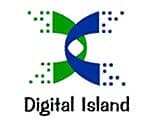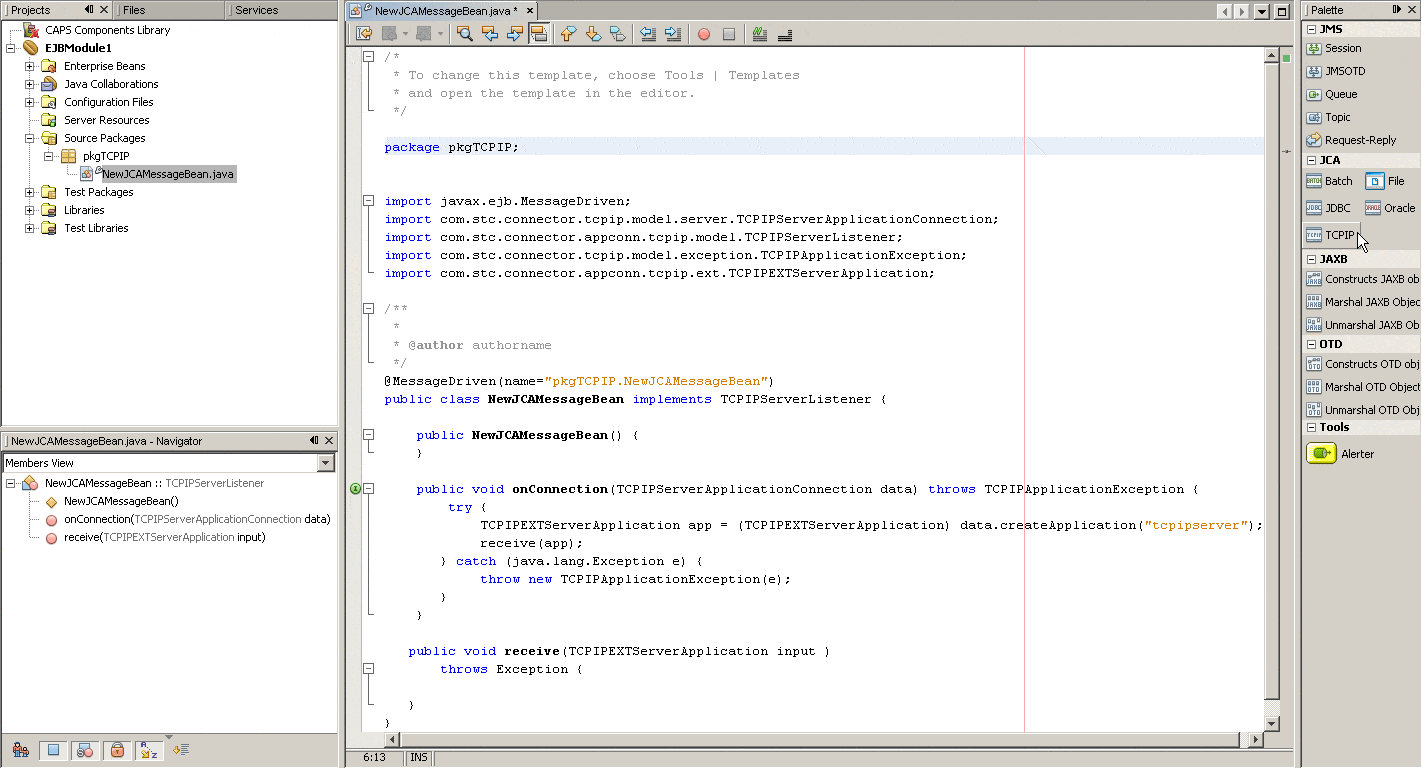
In my book, How I Made the Web World Wide, I chronicle my journey as co-founder of Digital Island, a pioneering Internet infrastructure startup launching in 1996. With a bold vision, our team raised $779 million to forge a global telecommunications network that transformed human connectivity. Immediately thereafter, this framework enabled the most transformative event in human history – the globalization of eCommerce.
Look at the illustration below and envision yourself going back in time to 1996. The blue lines are the areas of service for regional internet service providers (e.g., France Telecom, Japan Telecom, Singapore Telecom, Deutsche Telekom). The red lines are the oceanic and terrestrial fiber optics of International Private Line Circuits (IPLCs) that I contracted for and put into service linking every major metro with an internet presence around the world.
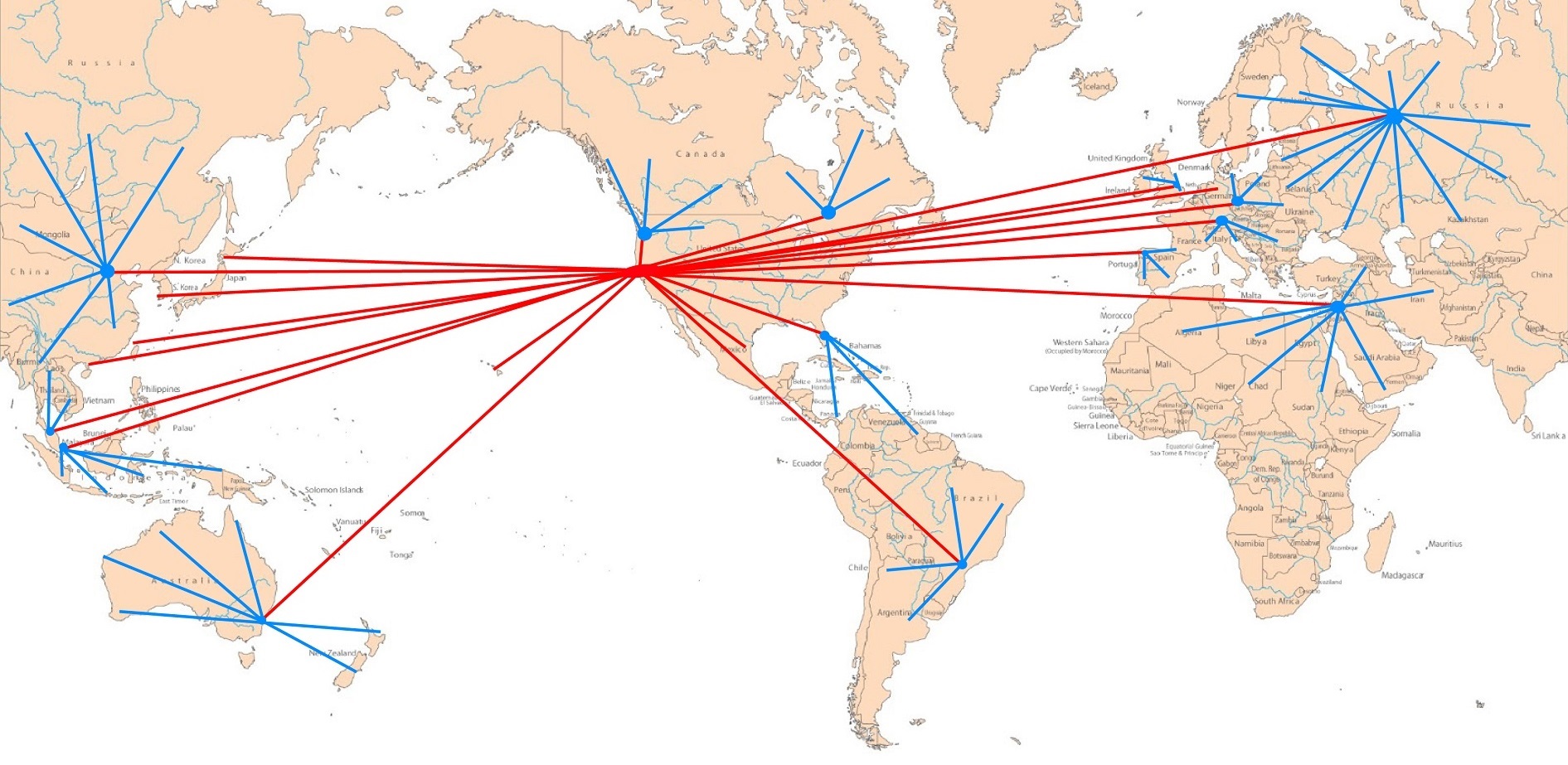
In my role, I was responsible for initiating the business opportunity of global e-commerce which included authoring the financial pro-forma identifying the prospective shareholder returns and drafting the initial engineering network architecture. During this time period, I also negotiated a contract with Cisco Systems to host their website (Cisco.com) which was promoted to obtain our seed capital from Cliff Higgerson at ComVentures (now at Castille Ventures).
With our funding now in place, I focused my energies on acquiring the network infrastructure that connected the world’s most significant ISPs and 95% of internet-accessible users together, seamlessly, for the world’s first Internet Protocol (IP) based and autonomous global wide area network (WAN), thereupon realizing the effective globalization of the Internet, Web, and eCommerce. This is the story of How I Made the Web World Wide.
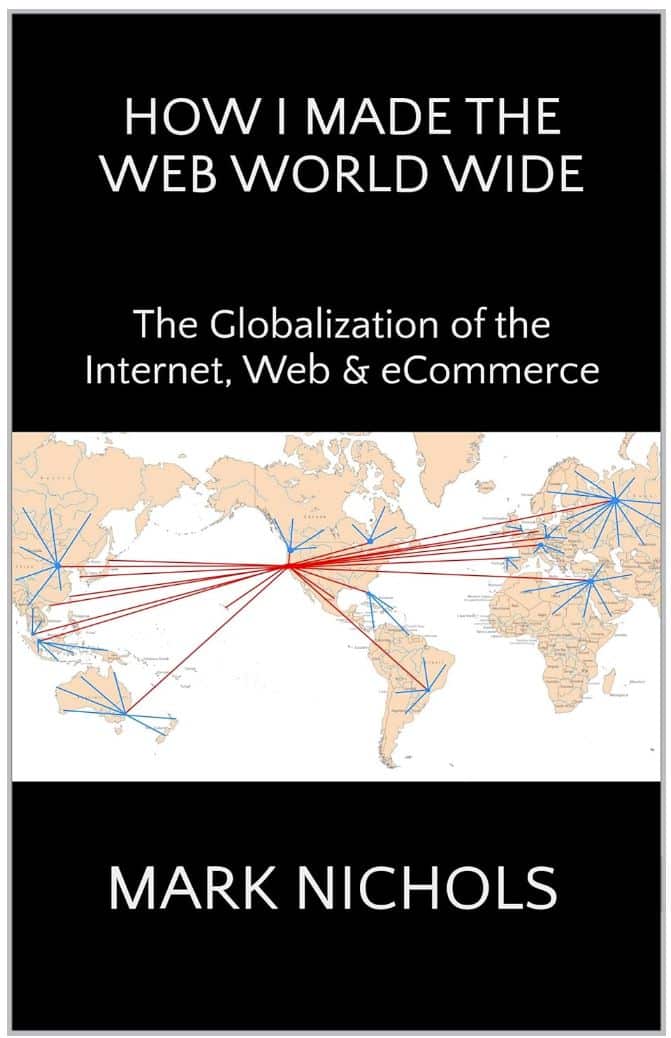
This book explains how our new global network enabled:
- The globalization of eCommerce with Visa, MasterCard, Charles Schwab, and E*Trade.
- The first internet peering connectivity with the People’s Republic of China, which I contracted for during my travels to Beijing to negotiate the terms of service with the Minister of Telecom, Professor Xing Li of Tsinghua University.
- The largest media streaming network in the world with Microsoft, Intel, and Compaq.
- The first global Content Delivery Network (CDN), aka Local Content Manager.
- The first Network-as-a-Service (NaaS) on-demand allocation of bandwidth over the internet, aka Reservation Resource Protocol (RSVP).
- In 1996, when I negotiated and signed a service contract with Cisco Systems to host Cisco.com, they were the 587th largest company in the USA. Three years later they became the most valuable company in the world while employing our network to scale their growth.
- The award and recognition as the world’s first Cisco Powered Network, which became the worldwide internetworking industry benchmark.
- The globalization of eLearning and ePublishing with Stanford University.
- The internet access platform that the Google’s founders used to build the first repository of search results while they were graduate school students at Stanford University in 1998 (google.stanford.edu) as we were Stanford’s ISP starting 1Q 1997.
- Traceware, a patented algorithm, developed together with Stanford University’s HighWire Press. This technology leverages real-time data processing to automate regulatory compliance for global media, addressing both regional and localized requirements.
The image below is the genesis network diagram to globalize the internet drawn by Mark Nichols, June 1996. The document conceptualizes the Points of Presence (PoP) for the first internet-centric global wide-area networking of AsiaPac, the Americas, Western Europe, and the unnamed PoPs representing the Rest of World (RoW). This rendering precedes the application filing of our company business license by 4 months.
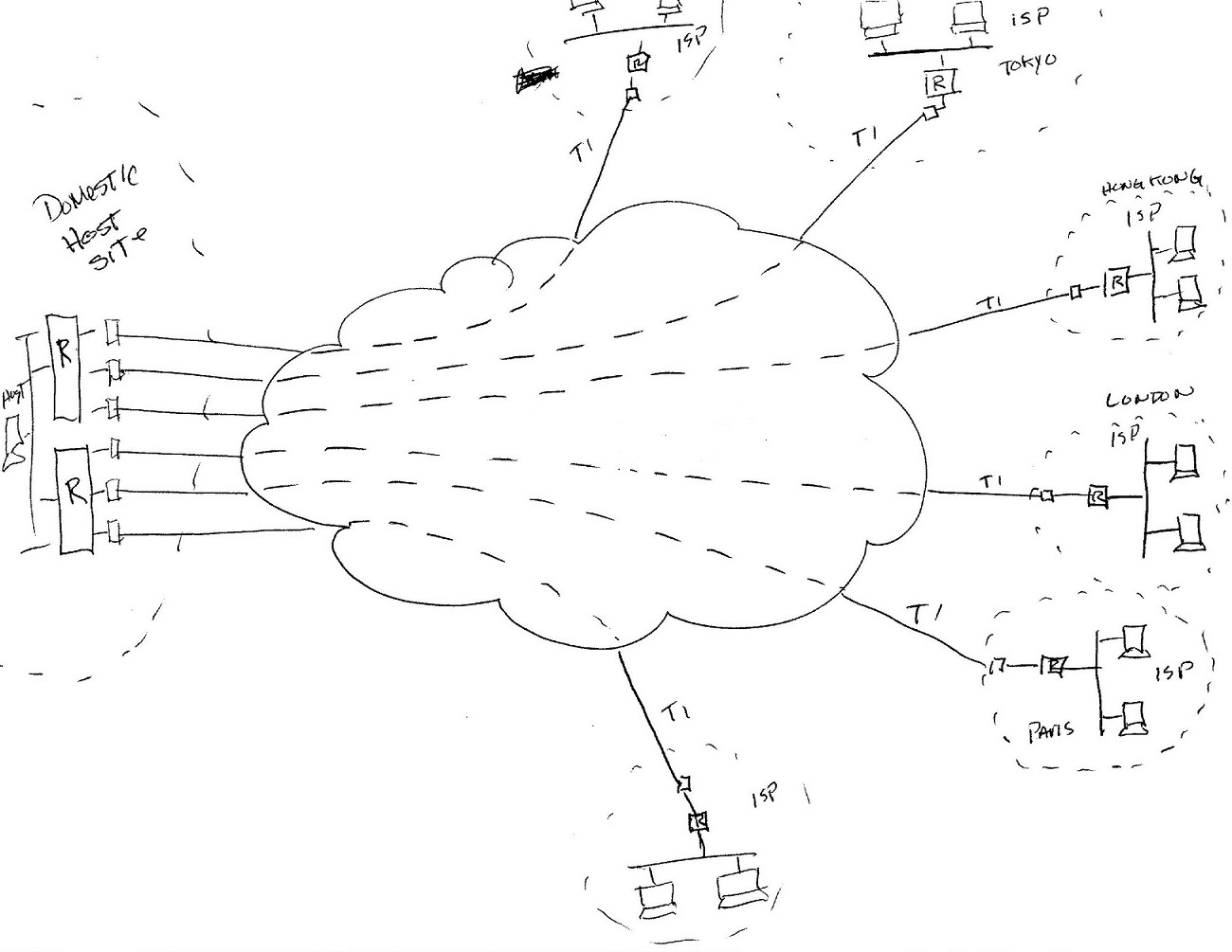
Within the book I share the historical perspective of the World Wide Web (WWW) application software stack, which allows documents to be accessed using the TCP/IP transport protocols, and that the WWW information system was initially prohibited from public use during the first 3 years after its development by the 12 European governments who owned it at CERN – Conseil Européen pour la Recherche Nucléaire.
At CERN, in 1990, Tim Berners-Lee, who was hired as an independent contractor, received a NeXT PC to perform his core duties from his supervisor Mike Sendall, where Sendall suggested TBL consider applying some of his time to his pet project: a CERN-centric phone book and document-sharing program envisioned to be OS-agnostic. Robert Cailliau, a Fellow at CERN since 1974, however, had envisioned a network since 1987 through his hypertext proposal. Cailliau, with TBL, co-authored the 1990 WWW proposal, introducing a “worldwide” vision, expanding it beyond TBL’s “for CERN use only” limitations.
This transformation relied on many key collaborations: Cailliau’s leadership, Nicola Pellow’s 1991 Line Mode Browser for OS-agnostic access, Dan Connolly’s HTML enhancements, and the expertise of IETF and NCSA contributors. Together, they drove critical milestones: the 1991 public release, the 1992 MacWWW browser, the 1993 public domain declaration, and the 1994 WWW Conference with 380 attendees. This collective effort reshaped Berners-Lee’s initial CERN-only phone directory and document-sharing tool into a worldwide initiative, laying the groundwork for an Internet-centric utility.
Following this, CERN initially held back the WWW software from public use, cautious about its potential beyond scientific circles—a delay that, while slowing early growth, by unintended default contributed to the eventual emergence of Digital Island’s first global TCP/IP network to take shape in 1996. To provide context, TCP/IP, the internet’s foundational protocol, was developed by Robert Kahn and Vinton Cerf in 1974; the WWW software stack emerged in 1990; yet by early 1992, only one website existed – http://info.cern.ch
Subsequently, with the debut of the Mosaic web browser in January 1993, and thereafter the release of the WWW software for public use by CERN in April, the number of websites increased to 130 by the end of 1993, then to 2,278 at the end of 1994, and then to 23,500 by the end of 1995.
At the time we started posturing our planned services in 2Q 1996, there were only 75k websites worldwide; as the internet had not yet experienced the investment to attain a mechanical and physical presence as a worldwide platform until our network went live in the last week in December of ’96.
To enable the potential of TCP/IP/WWW software required us to acquire entirely distinct elements of physical switch and routing equipment, server infrastructure, vast amounts of software and data collection structures, security appliances and licenses, legal viability, highly specialized expert human capital, paying customers, and billions of dollars of speculative capital with appropriations for shareholder return.
Over the next several years the words “internet” and “web” morphed into figurative terms used in a broader context than the stack of software systems that they really are. Though this isn’t technically the correct use of the words, they have become colloquially applied to describe the application of software technologies when used in large scale physical telecommunications networking infrastructure platforms.
In July 1996, I drafted this CAD network diagram on my MacIIcx using Aldus Pagemaker 4.0 and highlighted the need to move the hub from Hawaii to California. Hawaii—the original hub choice—sits at the end of an oceanic telecom spur reliant on California and lacks the fiber optic access, capacity, latency, and route diversity that we needed, a limitation I researched and discovered before sharing with Ron and others. So we rebooted the project at the Stanford University data center until we acquired our own facility nearby, as Stanford was our second customer (you can see the press release about that a few pages down). We also realized that storing data on an island with six active volcanoes within a 100-mile radius wasn’t a marketing win.
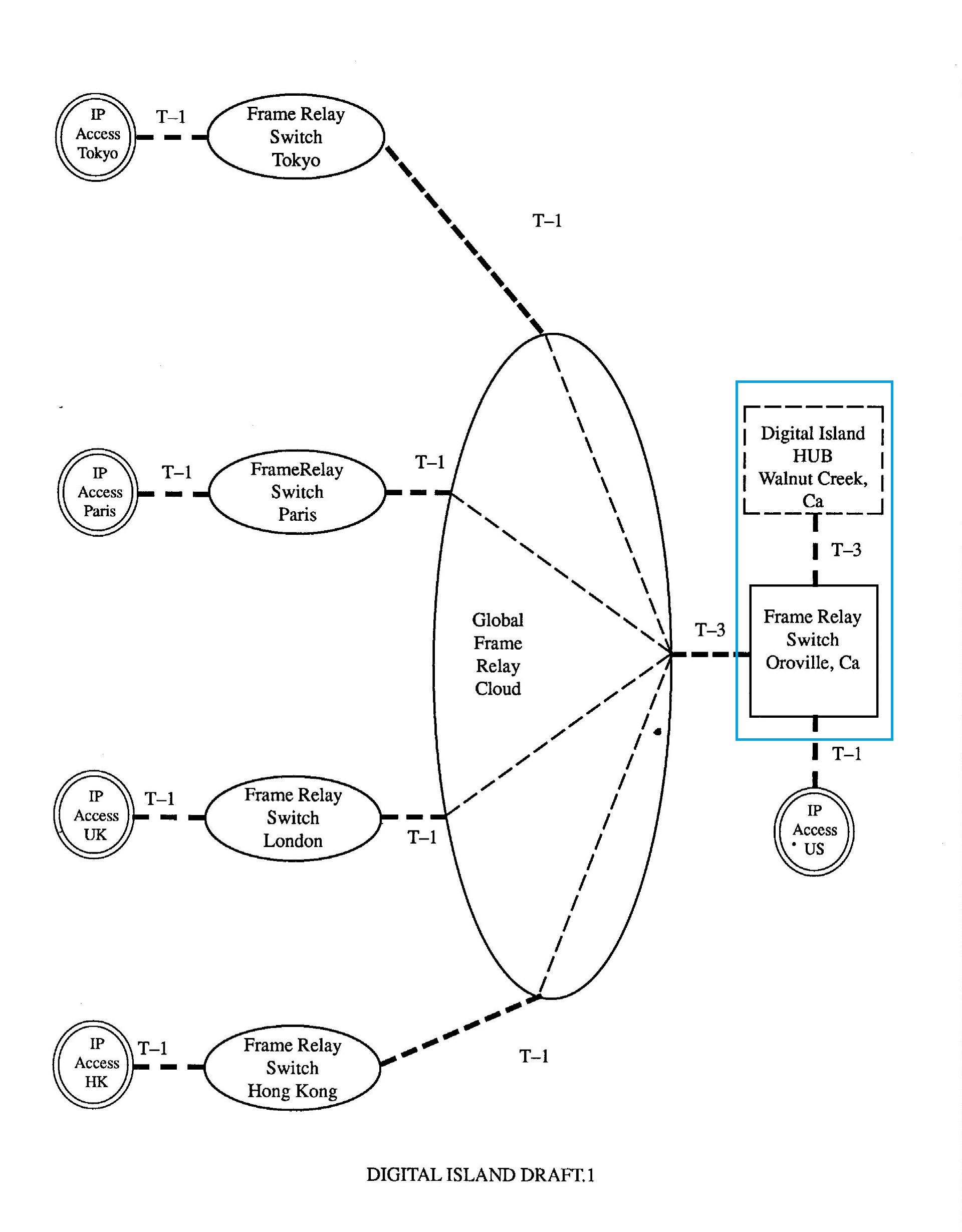
On August 5, 1996, I contractually joined together with Ron & Sanne Higgins to create Digital Island; we were now an enterprise of 3 people. Though we weren’t a business entity as of yet because the application for the business license was still a month out from being applied for. You can see that image nine paragraphs down.
At this time I was working without being paid an income. Though we had an employment contract at the time, in lieu of cash compensation I accrued a future “prorated stock equivalent” in a company that did not yet have municipal legality, corporate registration, nor securities assets. For the record, though there was talk of an investor, at this time there was no existent company business license or fictitious business name filing, thus there was no way to open a business bank account to deposit such funds, nor was there a stock instrument in place to securitize an investor.
Subsequently, we received investor money three months later, but only after I acquired our first customer, Cisco Systems. Within days of my negotiating and signing the service agreement, ComVentures wrote us a check for $300K in angel financing establishing their intention to lead the forthcoming first round of $3.5M in our Series A. With the Angel funding in hand, our newly onboarded CFO then initiated to provide our founding team with company paychecks and employee benefits for the first time.
The network illustration below I created as an evolution of the one above. I attached this diagram as an addendum to the service agreement with Cisco Systems for our hosting the cisco.com website that I negotiated and signed on November 7, 1996. You can see that contract two paragraphs down.
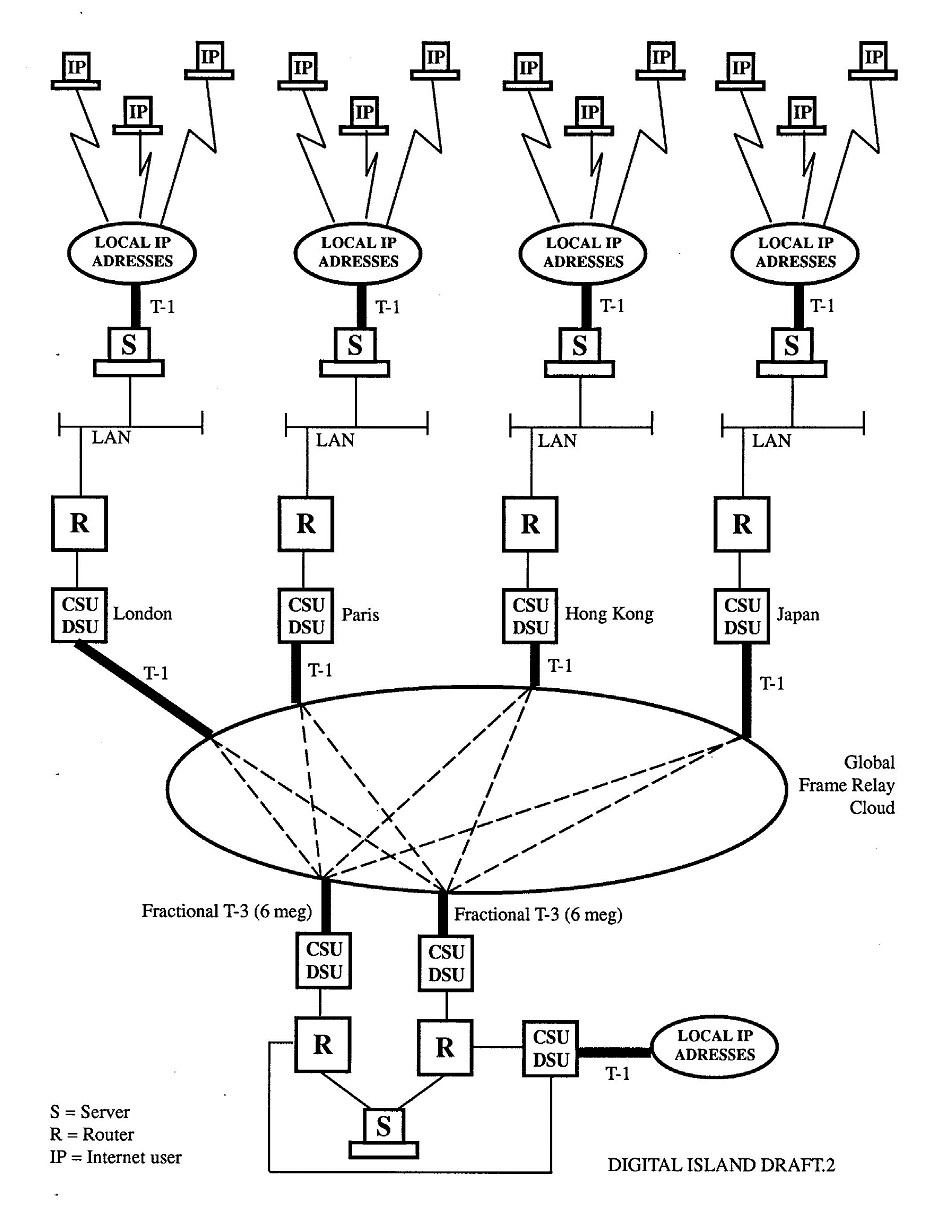
Note to peers: The frame relay (aka frame) network was swapped out to clear channel (aka International Private Line Circuits, or IPLCs) after our proof of concept in Q4 1996. The inherent vice of frame is that it doesn’t offer Quality of Service (QoS) for latency or security. We made the decision in mid-September of 1996 that we would modify our mission statement and attempt to globalize eCommerce with secure transactional services that I refer to as Merchant Transport; there’s more about this nine paragraphs down.
On November 7, 1996, I secured a landmark contract to host Cisco.com for Cisco Systems, a defining milestone for our 60-day-old, three-person startup. Collaborating with Cisco’s Lance Perry (VP of IT) and Herve Goguely (formerly the Senior Director of Global Service Management), we aligned on vision and execution. Their insights helped me to productized our proposed hosting services, build a robust financial model, set clear QoS metrics for service terms, then culminating in our signing the agreement at Cisco’s headquarters.
This contract, a proof of concept for Digital Island’s vision, secured $300,000 in angel financing and catalyzed $779 million in further investments. We rapidly recruited top talent to spearhead infrastructure procurement, deployment, and internetworking, building a global internet backbone in 1996’s emerging digital landscape.
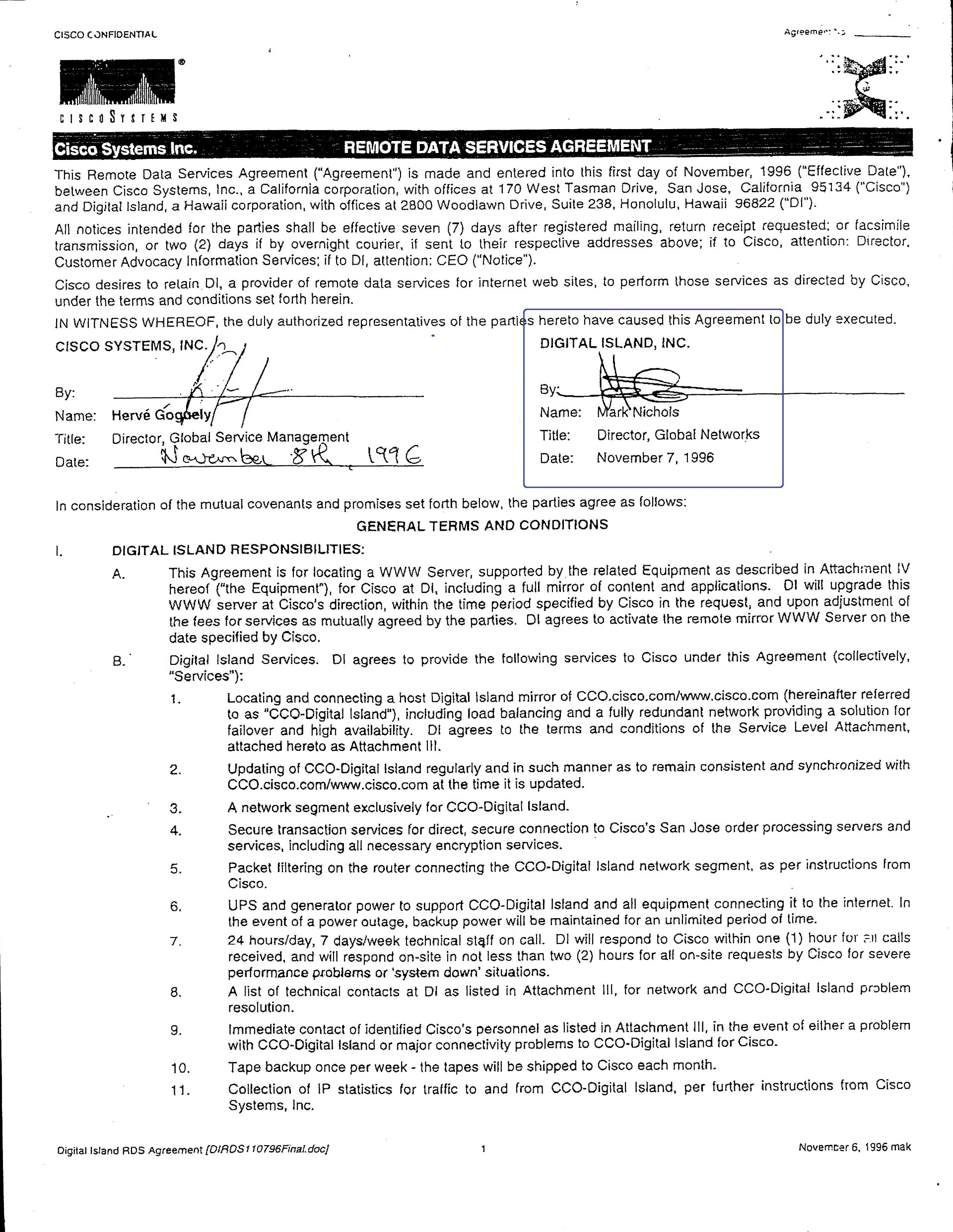
At the start of 1996, Cisco ranked #587 in the US Fortune 1000 for capitalization value. Three years later in 1999, Cisco became the world’s most valuable company. Founded in 1984, Cisco achieved this level of success for the first time in history that an internet company ranked as the #1 most valuable company in the USA and the world, and they accomplished it in just 15 years from startup. During this time we were the web hosting contractor and ISP for Cisco which provided that global scalability.
____________________________
As noted in the renderings above, to enable our change in mission statement to enable eCommerce, in Q1 of 1997 we pivoted to swapping out the frame relay ports in Hawaii to all new IPLCs demarcated to the Stanford University data center.
Though, at this moment in time, it is important to note that on September 6, 1996, the business was originally intended as a Pacific Rim-centric hosting and translation services entity focused on American content written in English to be translated into Japanese/Mandarin/Cantonese for the Pacific Rim markets. Ron initially defined the intent of the enterprise as a “Digital Publisher Service in the Pacific Rim”, but that business model changed significantly within weeks of this municipal filing. See the filing with the Hawaii Department of Commerce below.
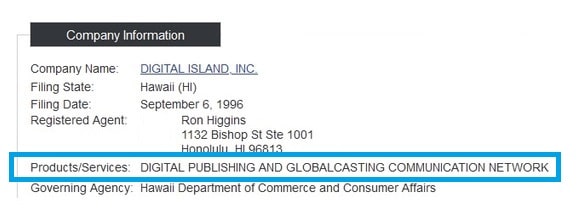

For the business application originally conceived above, the initial use of frame was preferred due to lower costs from the shared customer utility of line capacity; as frame is managed by the carrier, not the customer, and frame has an inherent burstable-capable design. Thus, for the digital publishing services company that Digital Island originally aspired to become, frame was the fastest way to market, the least expensive, has an immediately scalable architecture, and there is no engineering requirement for us to create our own team of network engineering and management, but, this plan was very short lived.
During my visit to Hawaii with Ron and Sanne in the second week of September we expanded the network design, expenses, and degree of difficulty to build and manage our own network, with the intensified goal of enabling Merchant Transport and the effective globalization of eCommerce.
The image is an email from Sanne, Ron’s wife and our Director of Communications, addressed to me on September 18, 1996—just 12 days after Ron’s business license filing for our “Digital Publishing Service in the Pacific Rim.” In the email, Sanne requests a copy of my proposed “Merchant Transport” financial services idea to incorporate into her marketing materials, which I had previously shared with Ron during our dinner conversation a few nights earlier.
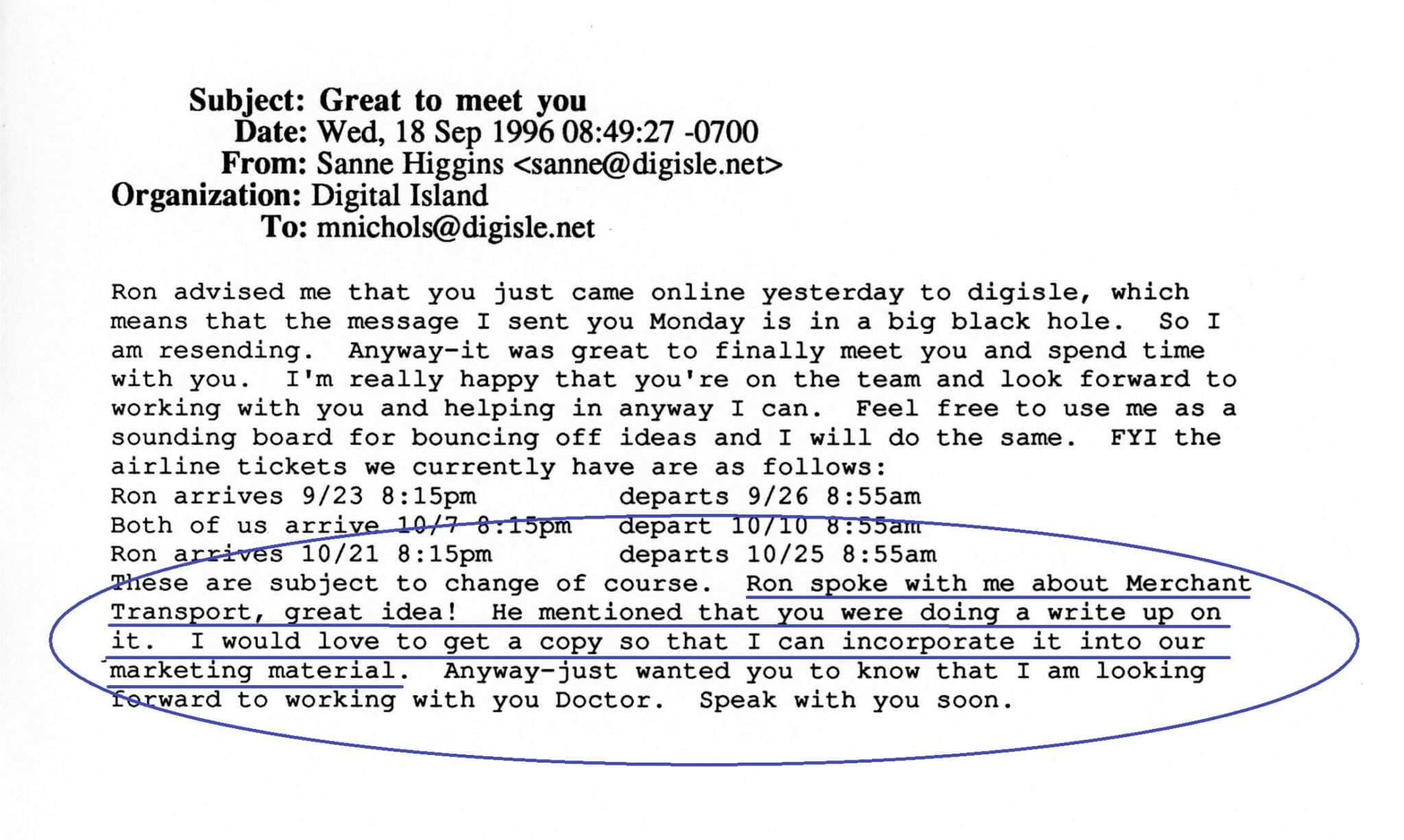
Within six months of this email, we had onboarded our third customer, Visa International, following Cisco Systems and Stanford University as our first and second clients. Soon after, we welcomed E*TRADE, Charles Schwab, and MasterCard into the network, cementing our role in the first to market of the global eCommerce landscape. This rapid growth was a direct result of the pivot sparked by the collaboration in this email—a decision that propelled us to connect 95% of ISPs globally, raise $779 million, and achieve a $12 billion market cap in just four years, ultimately scaling the internet to 5.6 billion users and $12 trillion in eCommerce.
A Quick Primer on “Transport” in Internetworking: In the world of internetworking, “transport” refers to the mechanisms and protocols that move data between two endpoints—sender and receiver—across a network for end-to-end communication, bypassing intermediate steps. A classic example is the TCP/IP protocol, a transport layer mechanism that ensures data packets are delivered reliably from a server to your device, guaranteeing a seamless flow of information across the internet.
From my initiation, productization, and financial pro-forma of Merchant Transport, and together with the critical contributions from other members of our team, we began experiencing the genesis of an internet-centric, worldwide financial revolution.
_____________________________
How did the caterpillar become a butterfly?
Now visualize:
1. Take away the red lines—that’s the “internet caterpillar” of 1996. This is before the first global network to facilitate seamless end-to-end internet access to all major metros and internet-available service areas around the world.

Imagine an “internet” where Rostelecom in Russia was not connected to Embratel in Brazil, Malaysia Telecom was not connected to Telefonica in Spain, Korea Telecom was not connected to NetVision in Israel, HiNet in Taiwan was not connected to Imaginet in France, Telstra in Australia was not connected to Deutche Telekom in Germany, and China was simply operating on a single 64 kilobit intranet (64 Kb is a single telephone line of capacity) shared amongst their 300 member universities with a single 64 Kb to SprintLink. The timing of user adoption rates was a key issue here as the economies of scale for globalization had not yet been financially viable with a solution to generate shareholder return on such a large scale of a worldwide networking endeavor.
Without seamless global connectivity, the internet protocol suite, which incorporates the World Wide Web application layer protocol software code, does not avail internetworking usage outside of local hosts, regional footprint, and limited peering relationships. Consequently, ISPs and enterprises that were using the internet and WWW software primarily applied it in use within their corporate or regional-wide networks, aka intranets.
Therefore, the potential and suggested usefulness of the Internet and World Wide Web software protocol applications, with only their regional or private corporate implementations, remained uncertain, and thus, the internet protocols were serving merely as a “World Wide Web” in software title only. At the time, worldwide utilization could have been achieved with the software protocols, but at the beginning of 1996 no one had yet implemented the internet protocol software into service on a single, end-to-end, autonomous global network.
In 1996, when I began building this network, ISPs were territory-focused within their own regional network infrastructure. An example is France Telecom and Japan Telecom, which mostly service French and Japanese businesses and consumers, respectively. They offer services only for internet access to content within their sphere of influence and limited peering relationships, which physically limits their network footprint and electronically compromises the customers access to content beyond their network intranet.
You could have a website or web-centric application anywhere in the world, but that does not mean everybody in the world could access or use it. By design, regional ISPs did not guarantee access to content outside of their networks, especially to content in other countries or stored in networks located on other continents. Prior to our network roll-out, QoS for the internet did not exist before we guaranteed 300 milliseconds (aka 3/10th of 1 second) round-trip to anywhere in the world, at anytime. Our network QoS enforcement is what enabled our ability to globalize eCommerce.
2. Now put the red lines back in—that’s the “internet butterfly” infrastructure metamorphosis of globalization that we started in 1996. Keep in mind that the butterfly is co-dependent on the caterpillar stage. These global private lines that I acquired spanned the world and created the first global ISP backbone, interconnecting all major regional ISPs within each metro, thus this network metamorphisis is what realized the full capability of the internet suite of software protocols.
By January 1999, the Digital Island network had connected all the world’s major ISPs that were currently available for internet connectivity, including those in England, France, the Netherlands, Germany, Spain, Russia, Israel, Mexico, Brazil, Australia, Singapore, Malaysia, Hong Kong, Beijing, Taiwan, Japan, South Korea, Canada, Miami, New York, Los Angeles, Boston, Chicago, Virginia, Seattle, Honolulu, Palo Alto, and Santa Clara.
From a historical perspective, the solutions introduced above were a new market opportunity because our global network services did not pre-exist prior to our company start-up, and thus, we were able to contract to host and broadcast the websites to 881 customers in under four years from our company’s inception.
These clients included Cisco Systems, Stanford University, Microsoft, Google, Visa, Intel, Compaq, Hewlett Packard, eTrade, Charles Schwab, Novell, National Semiconductor, MasterCard, Sun Microsystems, Sandpiper Networks, NetGravity, Canon, AristaSoft, Universal Music Group, ABN Amro, UBS Warburg, Digital River, Wall Street Journal, Financial Times, EBSCO Publishing, Fox Broadcasting, ZDnet, Reuters, Kenneth Cole, MSNBC, Major League Baseball, Time Warner-Road Runner, AOL, CNBC, JP Morgan Chase, Sony, Bloomberg, and over 850 others.
Note that with 881 customers in four years and with 220 business days a year, our customer acquisition rate averaged one new customer every business day for four years.
With the above in mind, to accomplish our goals we would need to connect all of the Tier One ISPs around the world that were actively participating in internet services. By connecting all of the Tier 1 telecom ISPs worldwide, we would become the world’s first “Tier 0” carrier/ISP. Although the term “Tier 0” is not technically used by tradition, it serves conveniently to describe our efforts to organize the legacy Tier 1 incumbents worldwide. Therefore, our business statement and executive summary aimed to position us as the network services tier above them. It was also the foundation for acquiring our customers, investors, service providers, and highly specialized human collateral to make it all materialize.
What we believed is that you can dream as much as you want, code as much protocol software as required, and raise as much money as you can, but eventually, highly qualified and valuable individuals must choose to join your company, perform the work that transforms emergent technology into a service, and then provide the ongoing and scalable support for all of it. It was the people who created the networking inventions, and those who made the investments, the installations, and the career commitments who are the people that sparked the revolution of information sharing and, in doing so contributed to changing the way people communicate and transact.
____________________________
The following content on this site will provide a brief overview of how the financial and commercial sectors became involved in my team’s entrepreneurial journey, which started with the creation and assembly of a business case, network architecture, customer acquisitions, specialized human capital, and a $779 million speculative venture capital investment. Beginning in 1996, we started making this investment to fully realize the potential of those software code protocols, originally written and intended for worldwide implementation twenty-two years prior for TCP/IP and six years prior for WWW.
Below is our company’s first press release announcing the above services contract to host the Cisco Systems web site and the announcement of our “NEW GLOBAL NETWORK.” January 1997.
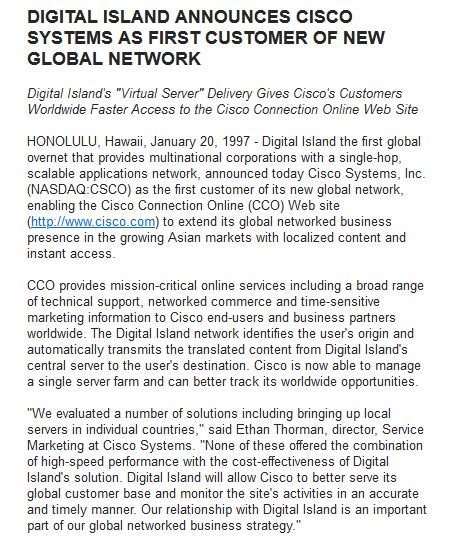
___________________________
We acquired our second customer, Stanford University, for the enablement and distribution of their e-Publication and e-Learning services. Prior to this press release, I had already initiated our first California network POP on the Stanford campus in January of 1997.
Stanford was one of the first two nodes of the internet, along with UCLA, in 1969, and we were now hosting and broadcasting their website on our global network in 1997. Consider the magnitude of the value proposition of our global network, such that Stanford and Cisco were our first two clients. Our services also included providing Stanford with the internet platform that the founders of Google used for upstream ISP connections to build the first repository of Google search results, while the founders were graduate school students at Stanford University in 1998 (google.stanford.edu).
With Cisco and Stanford on-boarded, the world of technology and finance began to take very serious notice.
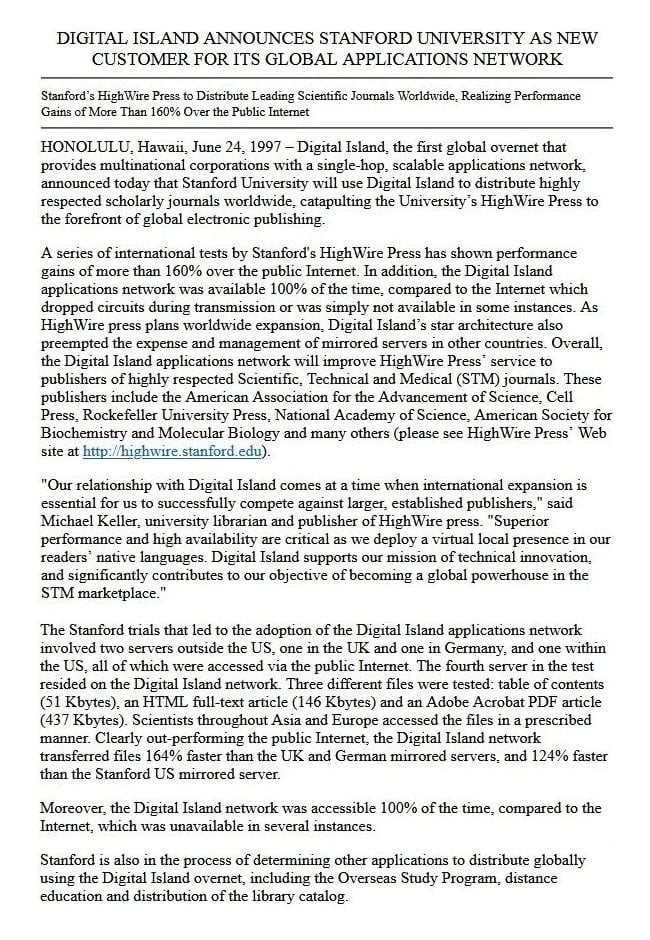
____________________________
The press release for our E*Trade customer acquisition, investment, and board seat. Prior to this, we had Visa on-network since 1997, and it was only a few months later that we brought online Charles Schwab and MasterCard. Seamless and global eCommerce with Visa, MasterCard, Charles Schwab, and E*Trade were all simultaneously available on a six-continent scale, in effect for the first time in every major metro worldwide and only available on our network.
And thus, from these milestone achievements, we enabled the globalization of eCommerce.
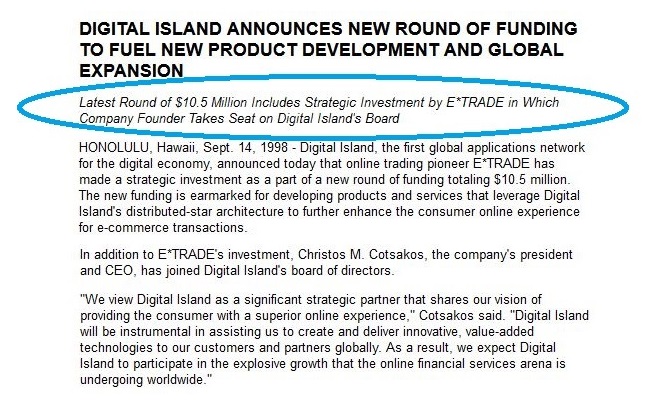
____________________________
For a little trip down memory lane, the three images below are the original receipts for the first tranche of SunMicro servers we acquired to build our global network and make the web worldwide. The shipping dates are September and October 1996. Note that the shipping of the servers is addressed to my residence in Alamo, CA, because I’m still working from home until we received our $3.5m A round investment in February. With that funding, I then contracted for 14,000sf of office space in San Francisco’s Embarcadero for us to facilitate the first 100 employees.
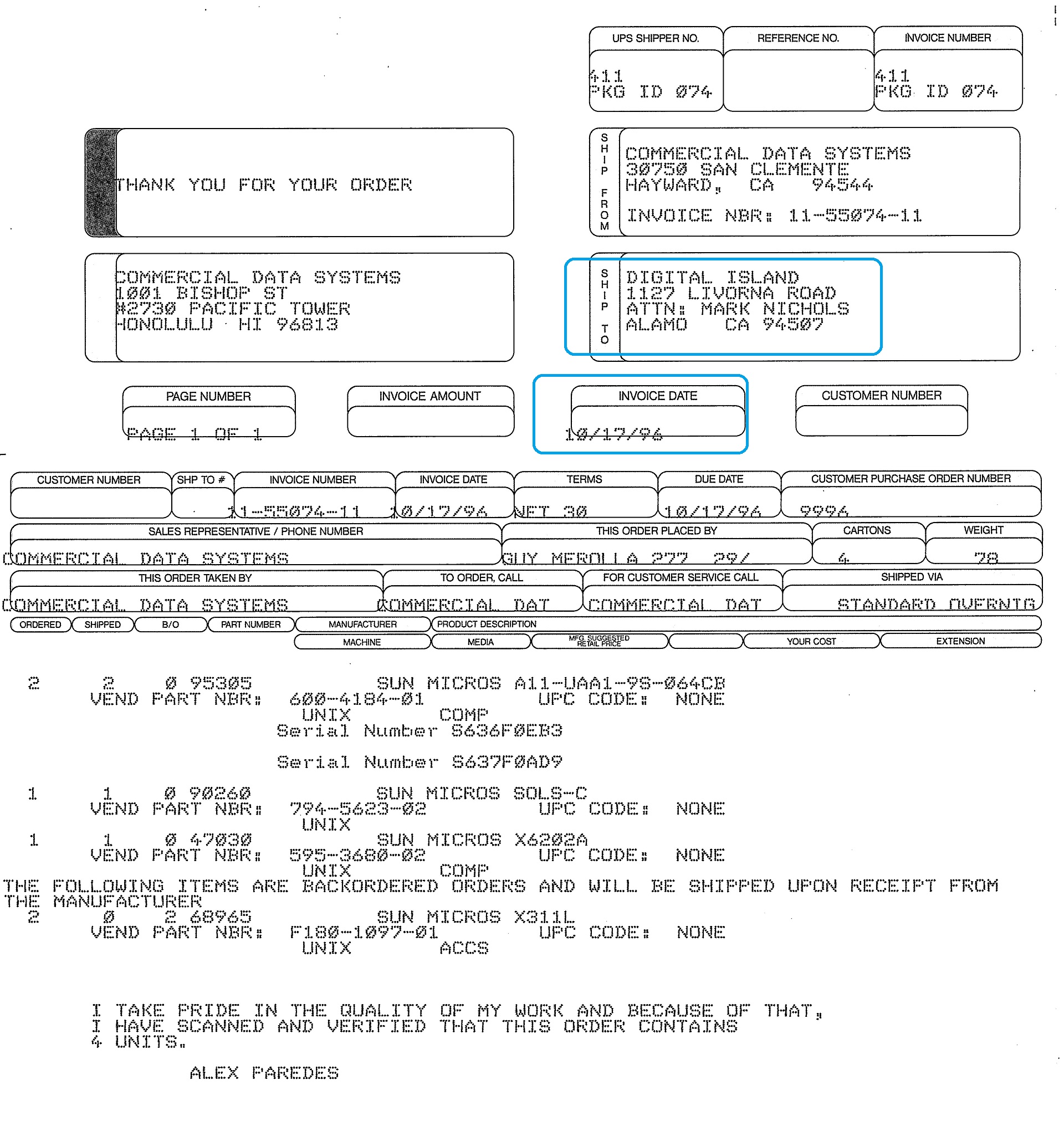
____________________________

___________________________
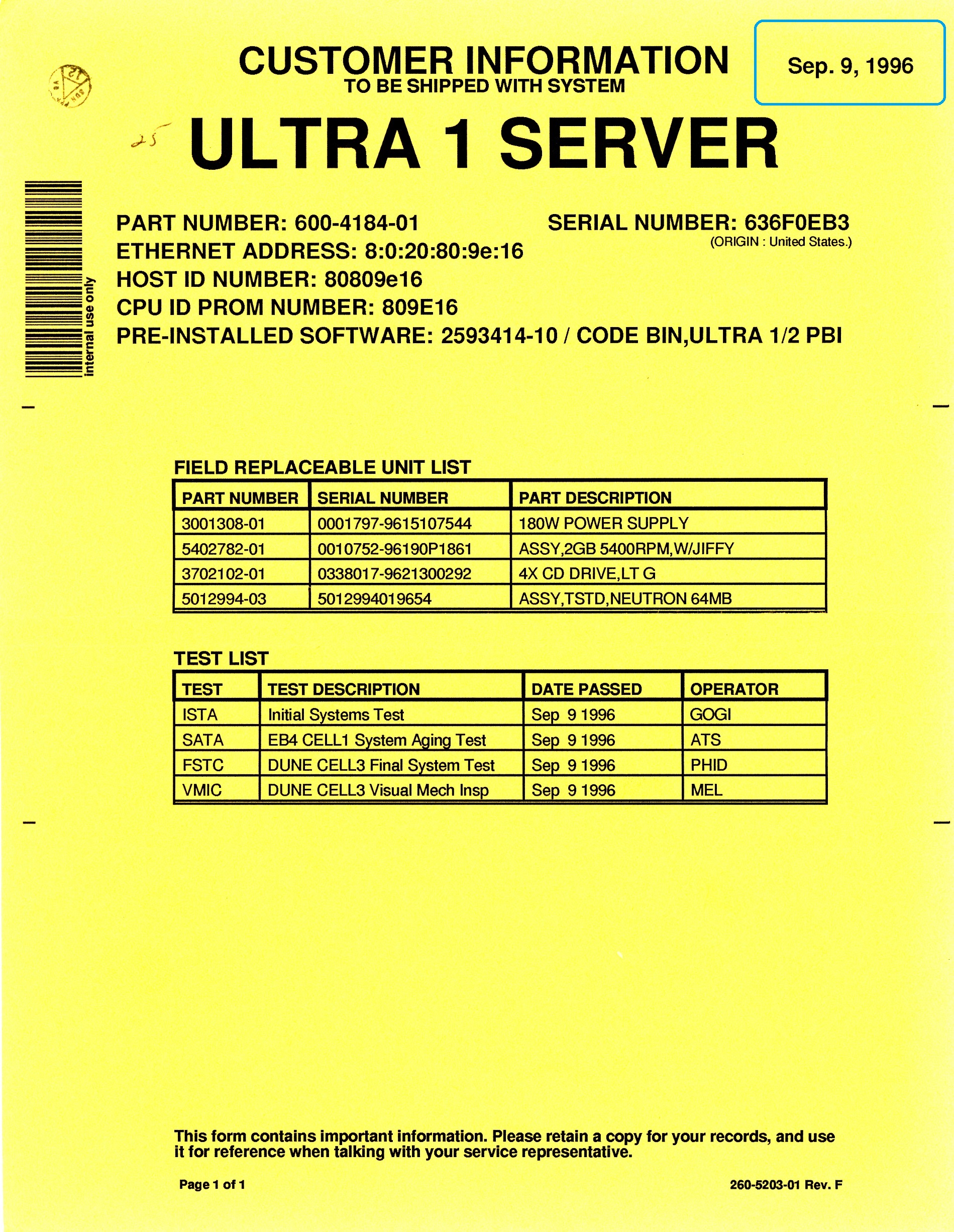
____________________________
The following images are a sampling of the pages from my passport, which document my business development travels to acquire the infrastructure to build our global network.
The first image below, with the blue square outline on the right side from Beijing, is the date stamp of my travels to visit with the Minister of Telecom (Professor Xing Li, Tsinghua University) to negotiate and contract for the first internet peering with the People’s Republic of China, and more specifically, to access the China Education and Research Network (CERNET).
At that time, China accounted for 18% of the world’s population but had only one telephone line for internet access and intranet networking serving the entire country.
To connect China to our network in 1998, I contracted for a submarine and terrestrial cross-continental circuit, which cost my cost center $275,000, prepaid and upfront (not adjusted for inflation). The contract terms required me to pay the circuit and port fees three months in advance.
The short story about peering with China is on this page https://marknichols.com/china
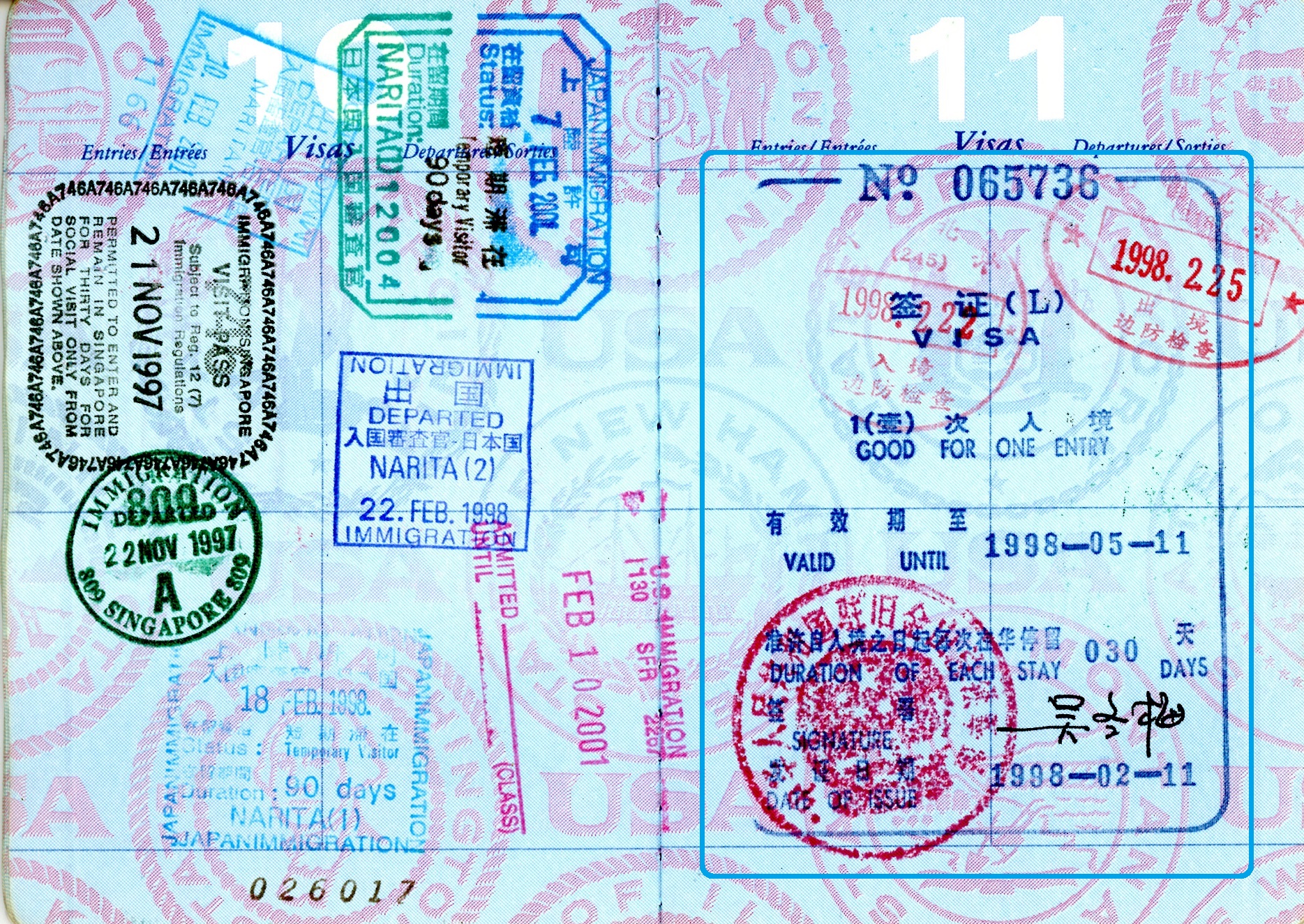
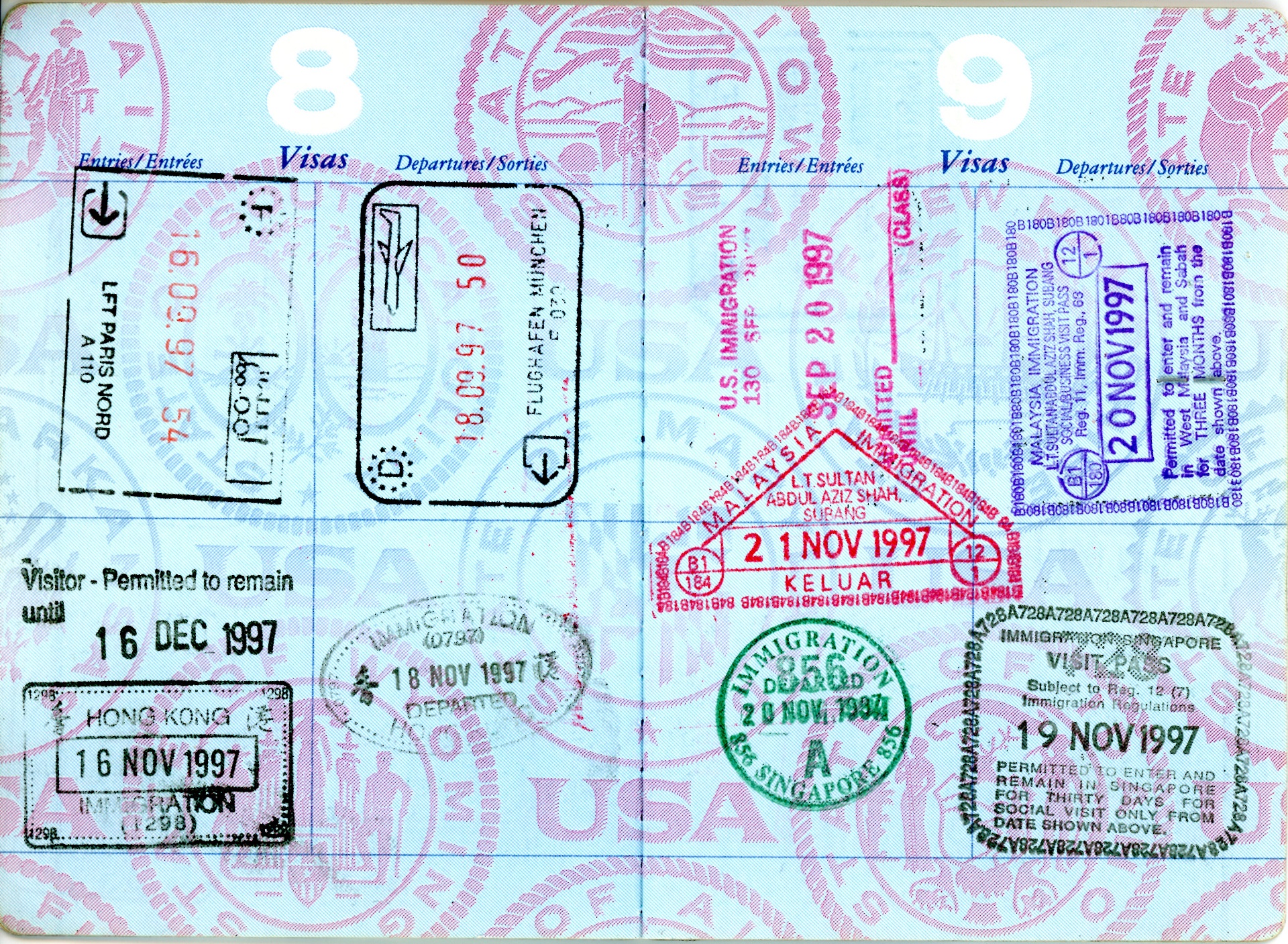
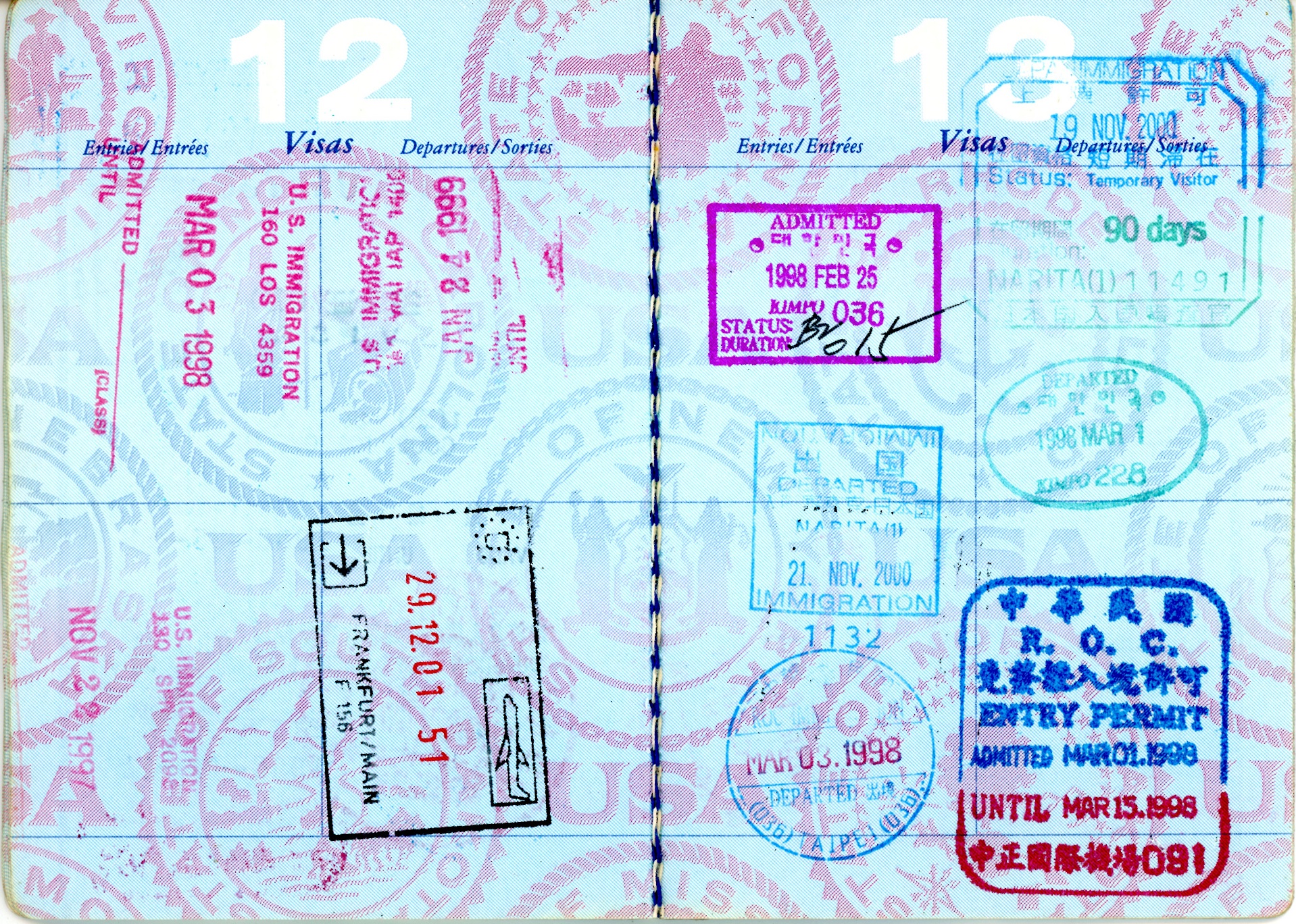
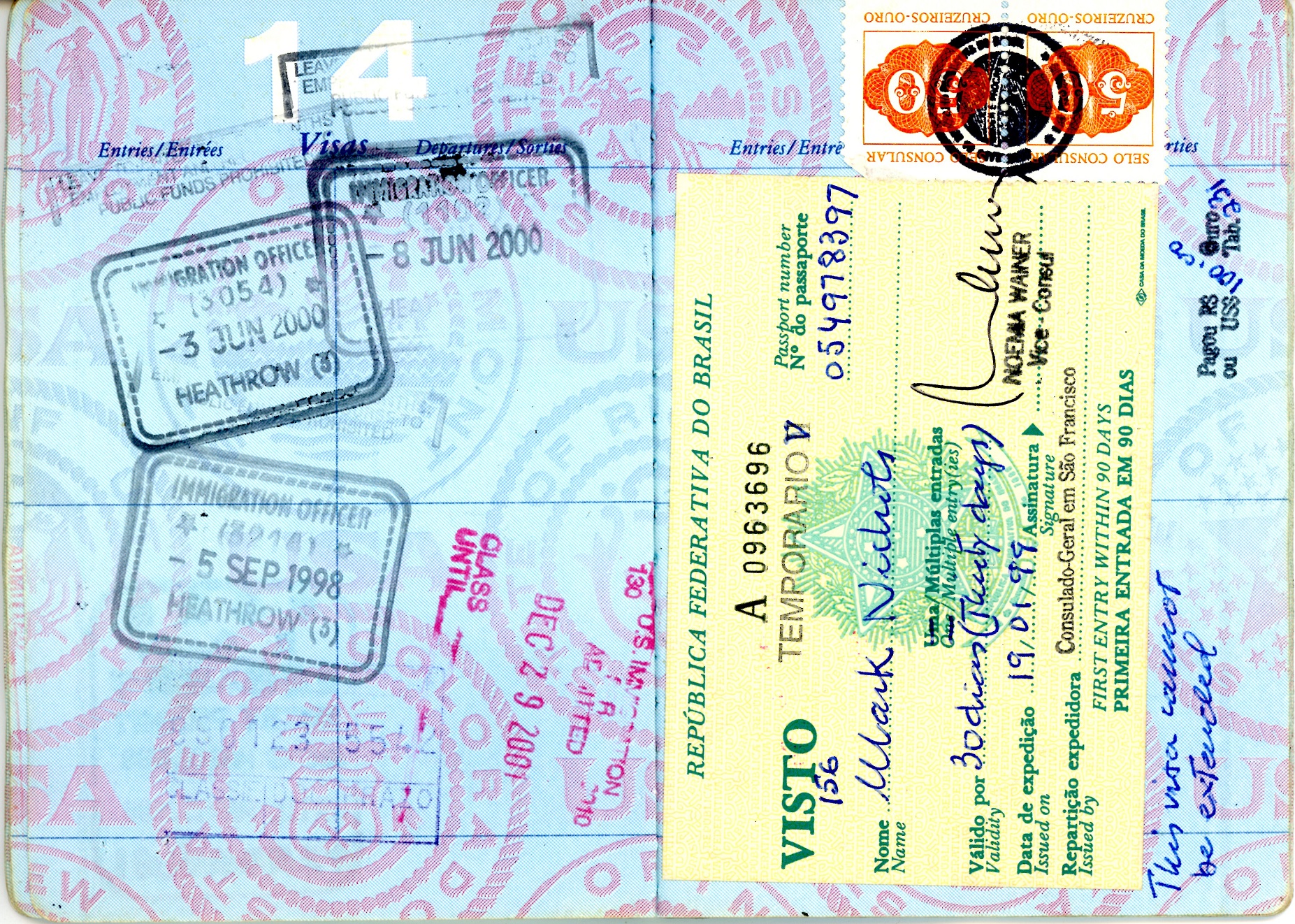
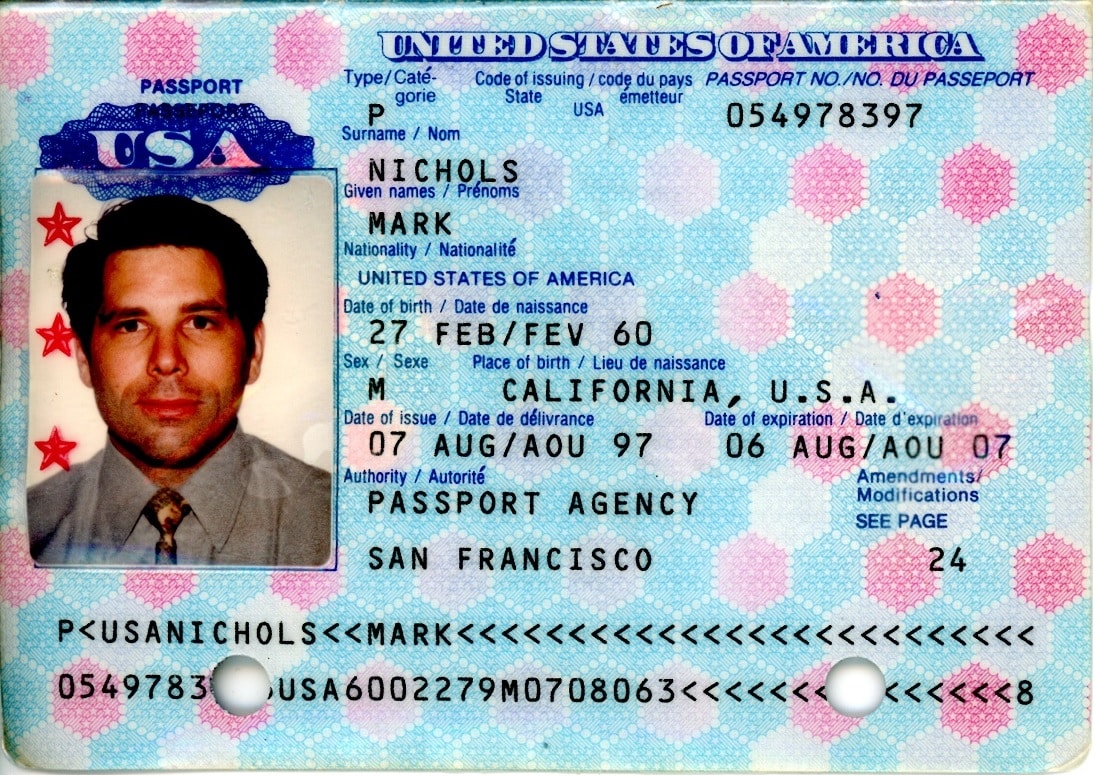
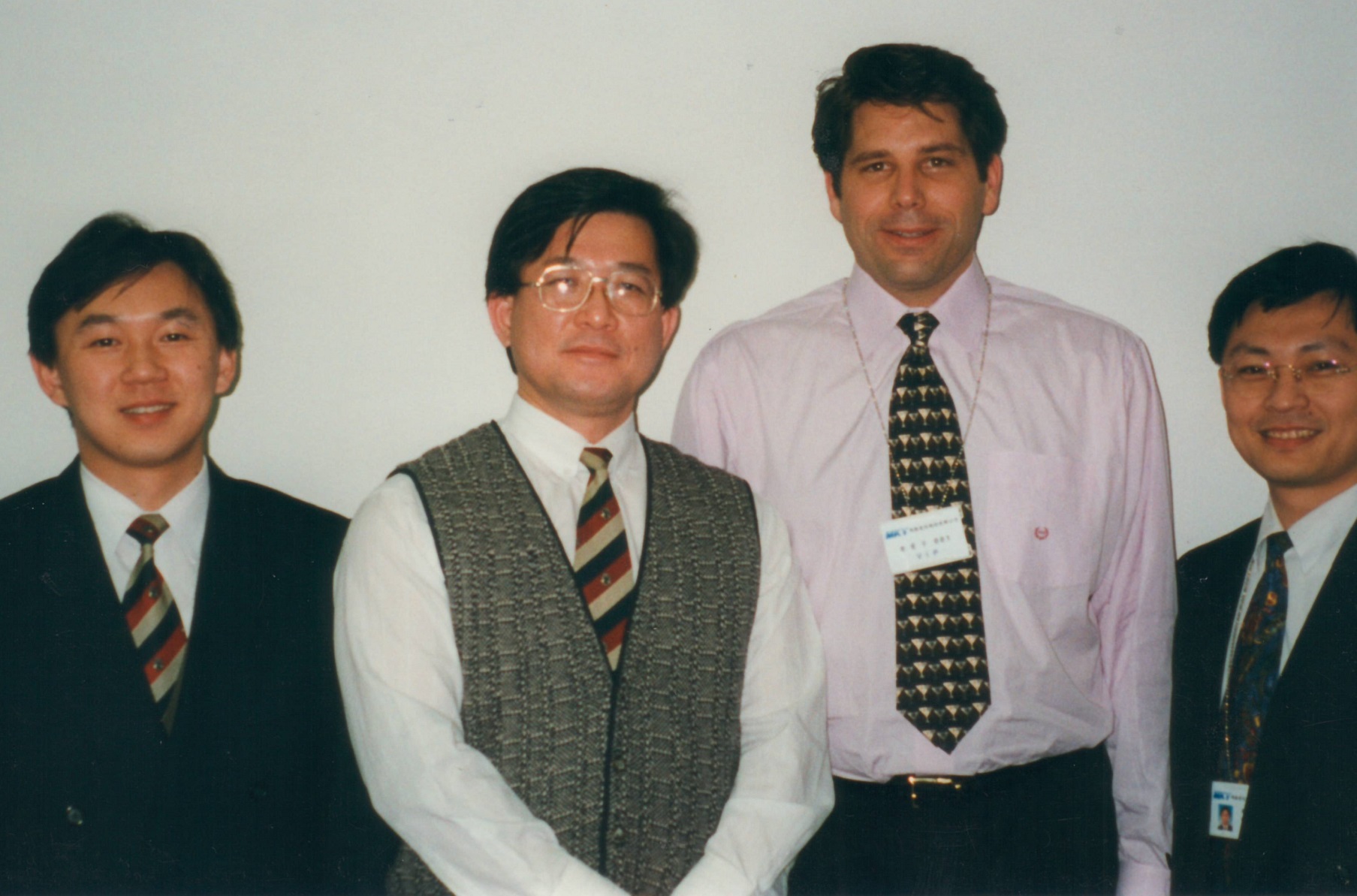
____________________________
The following press releases are about the data centers I acquired around the world to add to the infrastructure required to build our global network and facilitate what became the world’s largest media streaming network.
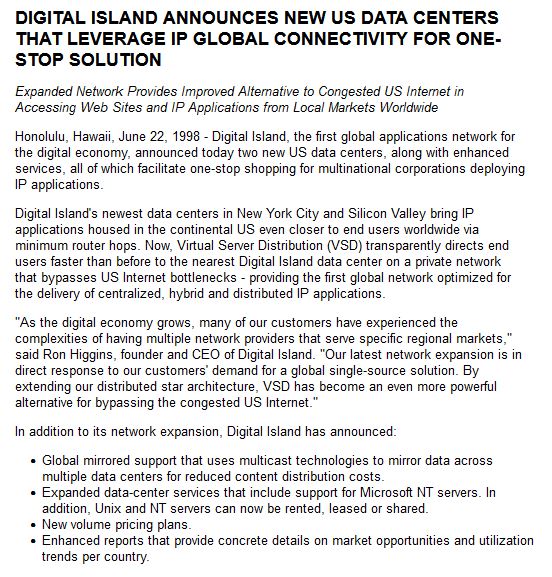
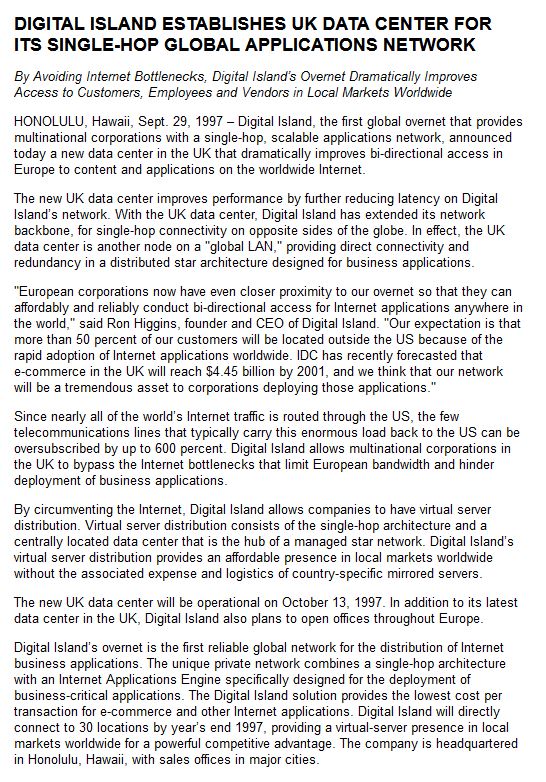
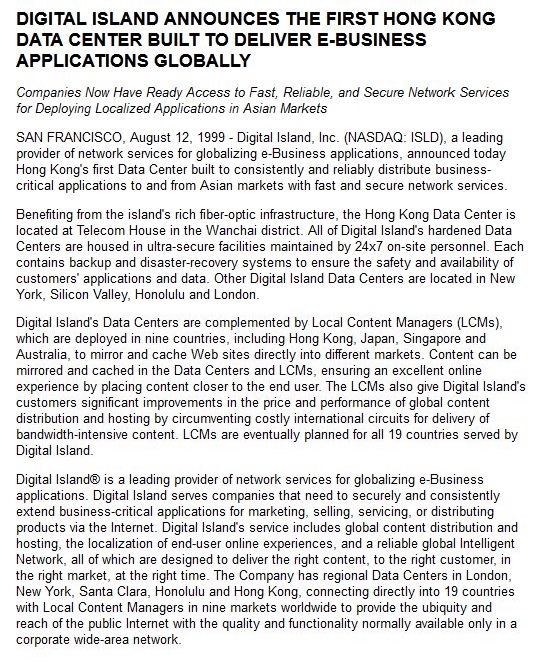
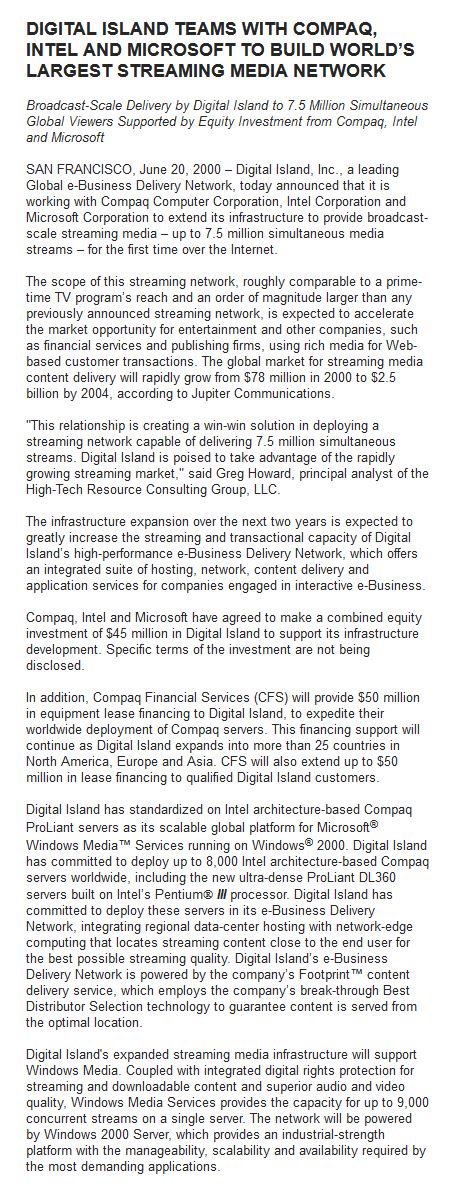
____________________________
As introduced in the opening paragraphs, internet protocols are neither the physical internet nor the web. To realize the potential of such software authorship, somewhere, somehow, somebody has to raise the money to pay for network and telecommunications expenses. The following outlines what Digital Island’s finance team accomplished, which funded the acquisition elements that made the Digital Island global network infrastructure:
$300K Angel Investment, ComVentures, November 1996
$3.5M Series A, January 1997
$10.5M Series B, March 1998
$10.5M Series C, September 1998
$50M Series D, March 1999
$60M Initial Public Offering NASDAQ (ISLD). See the image supporting the S1 filing below.
$45M Private Equity investment from Microsoft, Intel, and Compaq Computers. See CMS MarketWatch article below.
$600M Private Secondary Offering, Goldman Sachs
$779.8M total equity raised
$12B publicly traded valuation at high water mark
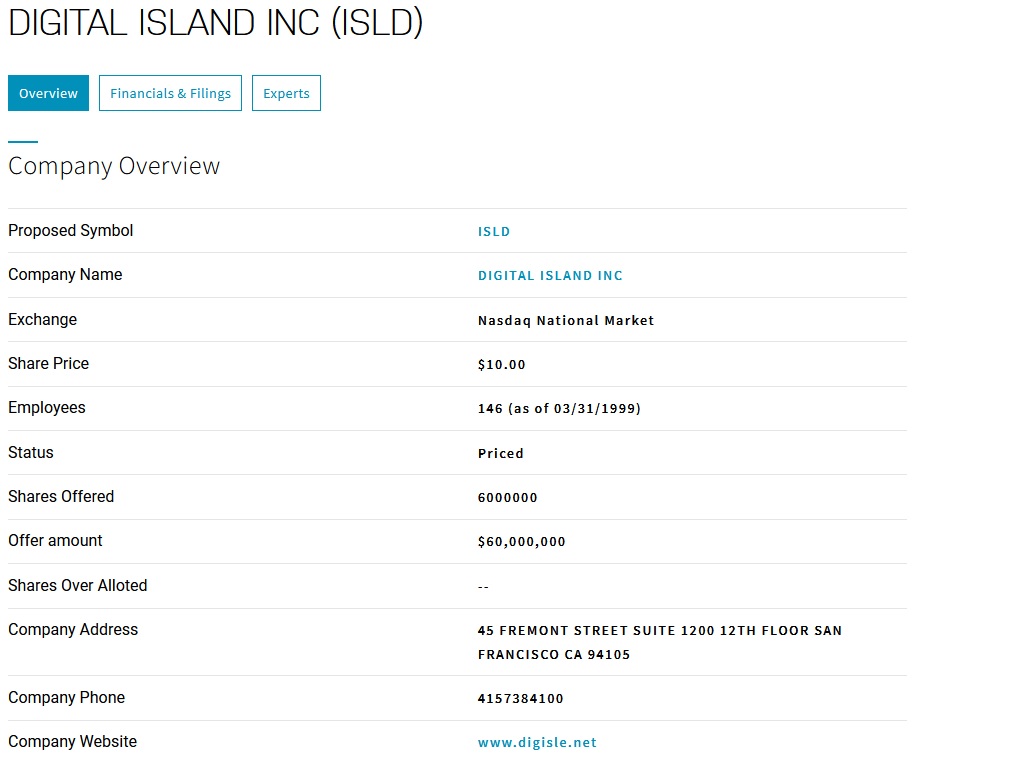
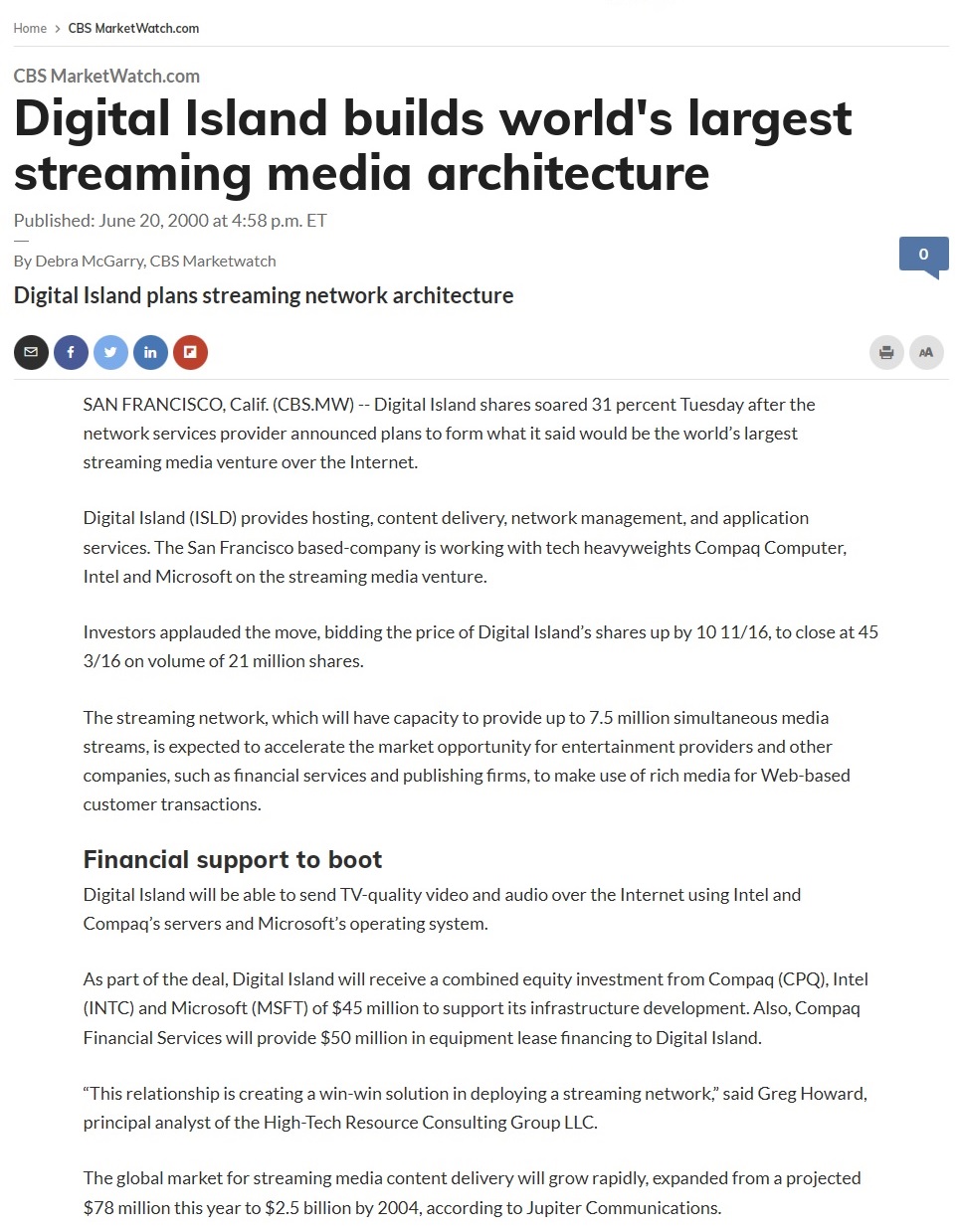
____________________________
On the global scale of internet use at the end of 1995, there were 23,500 websites throughout the entire world available to 7 billion people, and only 7,000 of those were not “adult-themed” content, which I will refer to specifically hereafter. I personally owned and operated one of those 7,000 websites, perfectwheels.com (see screen capture below) which made me a 1-in-a-million person on earth who owned and operated a website at the beginning of 1996. Additionally, those same metrics numerically invert to only 1 website per 1,000,000 people. Now, in 2023, there’s 1 website for every 8 people, for a growth rate of 43,500 times the increase in websites in just 28 years.
Anecdotally, this is the genesis for my suggestion of Merchant Transport detailed above. As was customary at this time, the industry standard to use a credit card “long distance” was either vocalized over the phone or the credit card information was sent via fax transmission. And thus, credit card fraud was omnipresent. By Digital Island enabling secure transmission while using a browser on our private network, this issue of fraud was overcome and the services of global eCommerce were manifested.


In the screen captures above, you can see that the website was image centric by showing pictures of the product. These images required a very long time to download with dial-up connections, as broadband was still a pipe dream (pun intended) at this time. The industry colloquialism for this was, “Trying to use the internet was like trying to suck a grapefruit through a straw.”
Anecdote: My website (perfectwheels.com) was a case study by Smart Valley, an association funded by Joint Venture Silicon Valley – Silicon Valley’s Institute for Regional Studies, working to coordinate people and technology with projects that enhance their quality of life. They featured Perfect Wheels as an example of how to launch an eCommerce business using internet and web browser technology.
____________________________
The number of internet users at the end of 1995 was 16 million worldwide; that’s only 1/5 of 1% (.002%) of the world’s population. The geographic distribution of those users was 2/3rds were located within the USA, and the rest of the world was cumulatively 1/3% of .002% of the population at .00075%. Now, at the time of this writing in 2023, there are 6 billion people using the internet worldwide, or 65% of the population, which represents a 375-fold increase in internet user participation in just 28 years.
Clearly, with the adoption metrics at 43,500-times more websites and 375-times more users in 28 years, the market opportunity for advancements in human communications and eCommerce was pre-existing. But, prior to 1996, the globalization opportunity had not yet been manifested with infrastructure and peering investments by the incumbent and monopolistic telcos in cooperation with governments. The incumbent telcos could have done it, but they, together with governments, strategized not to.
Further detail of the legacy telcos and government depravity and corruptness is beyond the scope of this introduction, but I address the Presidential Order that initiated the change in the vulnerability of human communications and the government-sanctioned retardation of such by the telecom monopolies in Chapter 1 of my book. Though, for sake of topic continuity and clarity, the following indented six paragraphs will discuss the above in condensed detail.
It’s not widely known that from 1990 when WWW software was initially compiled that the WWW software was reserved for government-only use for the first three years and was not available for public use. This changed in 1993 when the WWW was made available for public use and at no charge. Despite this new availability government suppression of global networking persisted in tandem with incumbent telcos until US President Bill Clinton signed the Telecommunications Act of 1996 into law. This act was the first in the world to strike down an important legal protection for telecommunications monopolies and oligopolies to solely provide telecommunication services. This made it legal for new service providers, such as Digital Island, to enter the internet and telecommunications services sector.
Thankfully, President Clinton and Vice President Gore brought into law the opportunity to “Let anyone enter any communications business—to let any communications business compete in any market against any other.” Thus, the statute is often described as an attempt to deregulate the American broadcasting and telecommunications markets due to technological convergence. The act was the first significant overhaul of United States telecommunications law in more than sixty years. The president signed the bill to revolutionize the way Americans get telephone and computer networking services.
This act will be memorialized as one of the most profoundly impactful acts of any president by enabling private enterprise to enter a former government-controlled and restricted field of utility. In a few short years, the act would change how globally diverse societies would proliferate their ability to communicate and trade forever.
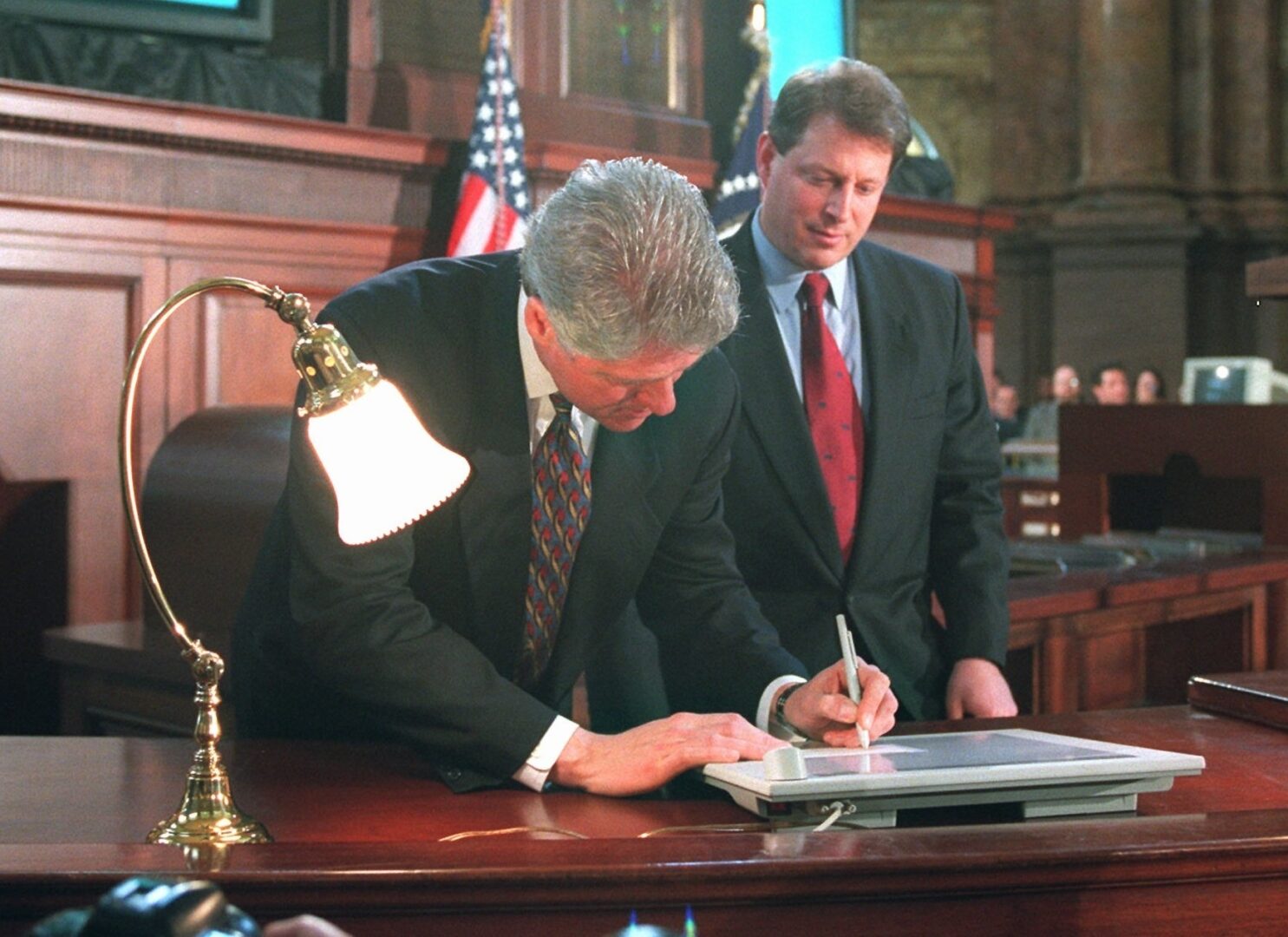
Thus, for this market timing opportunity in 1996 to present itself in the USA, it took an act of legislation at the highest levels of government. The act is actually a cancellation of the monopolies for telecommunications that have been in effect in the United States since 1934, and it ignited our entrepreneurial spirit to seize the opportunity.
Note that throughout the rest of the world there were still heavily regulated and protected monopolies existing for telecom. It’s an interesting fact that every IPLC and internet access port that I acquired around the world was technically illegal. Many of my initial inquiries to foreign Tier One telcos and ISPs went unanswered or rejected because Digital Island was not a federally licensed telecommunications carrier. In those countries, pre-existing laws prevented us from connecting to their networks.
In those cases, we only received special permissions, approvals, waivers, or amendments to the terms of service to interconnect with their networks after I traveled to their foreign offices and made an in-person presentation of our proposed network’s opportunities. These legality and government compliance issues with the rules and regulations of the Securities and Exchange Commission (SEC) were of paramount importance due to the financial and legal sensitivities we would have in eventually selling our stock to the public.
The intent and result of this presidential order was that in just a few short years, the above would change how globally diverse societies would proliferate their ability to communicate and trade by revolutionizing how Americans get telephone and computer services and allowing new service providers, like Digital Island, to enter the internet and telecommunications services industry.
Anecdotally, within 90 days of the law’s enactment, I started creating the global wide area network diagrams shared above, and less than nine months after the bill’s passage I signed the Cisco Systems Web Hosting Remote Data Services contract that started our globalization of the internet.
Thus, the aggregation and scalability of global telecom circuits had to originate and start in the USA in 1996 first, if it was going to happen at all, based on anywhere else in the world there would need to be the necessary legality, financial resources, investor vision, executive leadership, and the highly skilled human collateral to enable and support it. However, prior to 1996, these resources were only available, in aggregate, in the USA.
____________________________
Additional Reading about the History of the Internet Protocols and the World Wide Web Information system:
What actually is the internet and the web?
What actually constitutes the making of the internet and the web?
Who actually made the internet and the web?


- DNS: Paul Mockapetris’ 1983 creation, mapping names to addresses.
- HTTP: Berners-Lee and the IETF’s 1991 protocol, driving web requests.
- TLS/SSL: NCSA’s 1993 SSL for security, evolved into the IETF’s 1999 TLS.
- URL: Berners-Lee and the IETF’s 1994 standard, pinpointing resources.
- HTML: Rooted in SGML (IETF, 1986, ISO 8879), shaped by Berners-Lee and Connolly by 1993.
TCP/IP Code sample
WWW/HTTP Code sample
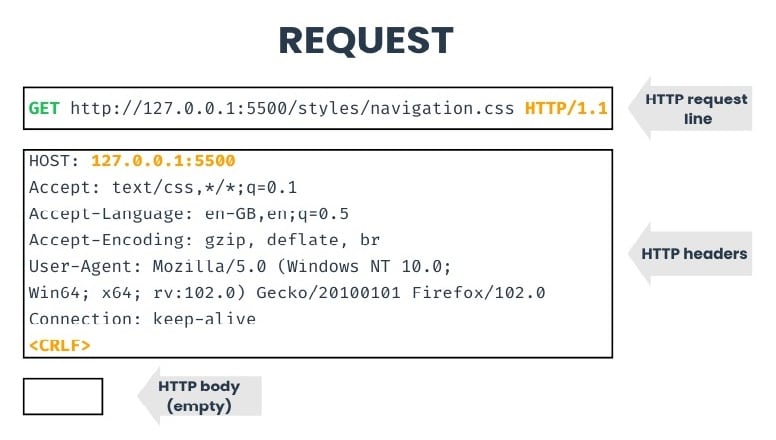
For the TCP/IP and WWW/HTTP protocols to function there are many other dependencies on physical equipment and software applications, each representing a different step of the transmission chain. When we transfer information from one device to another it travels figuratively through the 7 layers of the OSI model. First, data travels down through 7 layers from the sender’s end, and then it climbs back 7 layers on the receiver’s end.
As you can see illustrated below, TCP/IP and WWW/HTTP software protocols are a small part of what is required for collaborative transmissions to perform from one person to another, or across the globe, in what became synonymous and colloquially called the “internet” and “web”.
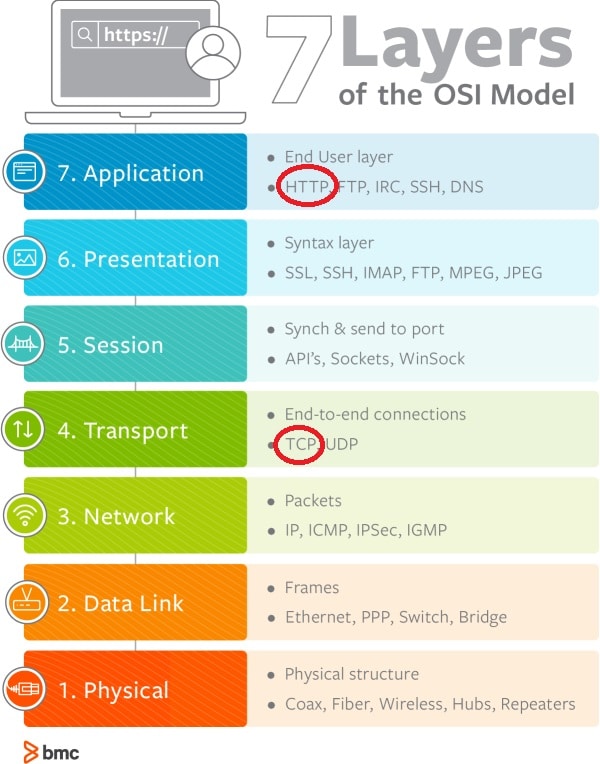
For a collaborative transmission, data flows through the OSI model in a step-by-step process:
- Application Layer: Applications create the data – WWW/HTTP participates here
- Presentation Layer: Data is formatted and encrypted.
- Session Layer: Connections are established and managed.
- Transport Layer: Data is broken into segments for reliable delivery – TCP participates here
- Network Layer : Segments are packaged into packets and routed.
- Data Link Layer: Packets are framed and sent to the next device.
- Physical Layer: Frames are converted into bits and transmitted physically.
Clearly, a minority portion of the software protocols running across a physical network and displayed in a desktop browser application do not independently nor physically constitute the internet or web. Furthermore, the actual realization of the internet as a functioning global network is a totally separate endeavor, costing billions of dollars in capital investment and requiring many different and entirely distinct areas of physical network, software contributions, infrastructure specialization, and vast amounts of expert human collateral.
The following diagram charts the proliferation of websites from 1991 to 2019. The graph clearly shows that the internet got it’s legs after we started the private investment to globalize worldwide internetworking in 1996 and subsequently went public on the NASDAQ in 1999 raising additional capital to increase footprint, capacity, and redundancy.
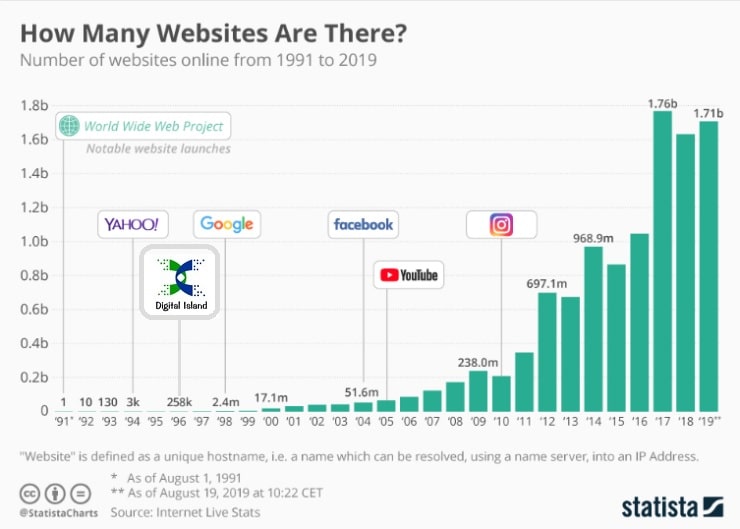
As previously shared above, the TCP/IP protocols were developed in 1974 and the WWW information system in 1990, but those software stack authorships required physical plant to be funded, installed, sold to customers, and proliferated.
The cause and effect are all quite simple: we enabled the globalization of internet connectivity and sharing around the world, and people and businesses alike rushed to use it. Clearly, the then pent-up demand was preexisting as evidenced by the statistics. Subsequently, the exponential growth of the global participation of internet technologies and infrastructure validated our business plan and our role in leadership as the first to market worldwide physical network installations, which led to the realization of internet globalization and eCommerce.
Note the website traction “hockey stick” of market adoption that takes off three years after we started hosting and broadcasting our 881 customers content and services, facilitated by our internetworking 95% of the world’s ISPs, and thus 95% of the world’s internet accessible population together by the year 2000.
Keep in mind that websites are a very recent innovation and a communications phenomenon. The Mosaic web browser, the first to display images in line with text instead of in separate windows, deserves recognition for this proliferation. Two programmers, Marc Andreesen (student) and Eric Bina (staff member), working at NCSA, the National Center for Supercomputing Applications at the University of Illinois at Urbana-Champaign, developed the browser, which saw its first public release in 1993. The browser’s indispensable role in popularizing the use of the general internet through the integration of multimedia is impossible to quantify.
With the above in mind, prior to 1996, there wasn’t a business case for regional ISPs to subsidize the investment of infrastructure from the monopoly telcos and interconnect with the rest of the world’s ISPs. This means, from a user perspective, that not everyone could see my website because their ISP wasn’t connected to my ISP. Therefore, having a website and an ISP hosting and broadcasting your content using WWW code did not mean your website was worldwide, and in reality it was quite the contrary.
Subsequently, the realization of the internet protocol suite and the World Wide Web information system when combined as originally intended with the many facets of the physical global network infrastructure triggered the explosive exponential growth of the internet and web, thereby fundamentally and profoundly revising our modern societies and civilization.
____________________________
So much happened so fast, impacting so many people, with so many cultural and economic influences, and with so many resulting aftereffects. It’s my hope that everyone appreciates the hard work by all the amazing people who chose to contribute to internet-centric telecommunications for the collective benefit of us all – as it was an incredibly difficult, expensive and unsecured endeavor with extraordinarily challenging goals.
“One of these days this internet thing is really going to catch on.”
Mark Nichols, 1994
____________________________________________
If you found the above to be of interest, please consider reading the book, as there is much more information about the adventure of creating the enterprise. The book spans less than 80 pages, with approximately 20 of those pages dedicated to images. My aim was to create a narrative that incorporated various sources such as contracts, press releases, photos, email communications, diagrams, and more, using the written prose to contextualize the images. For time budgeting, I estimate it will take most people about two hours to read. I tried to employ a writing style for non-industry people to make the story interesting and the readability accessible to everyone, but there is enough information to keep those who are in the industry captivated and informed.
How to contact Mr. Nichols
My daughters initially encouraged me to write this book, suggesting that I use it to teach university-level business students about technology start-ups and entrepreneurialism, including the principles and concepts of potential Wall Street investments through initial public offerings (IPOs). If you would like to contact me for a discussion about a speaking invitation for your school or institution, an educational series for students or employees, or something else, you can text or call 1-775-600-3400, or use this email: [email protected]
My book, How I Made the Web World Wide, is now available on Amazon. Click here to go to my Amazon page.

